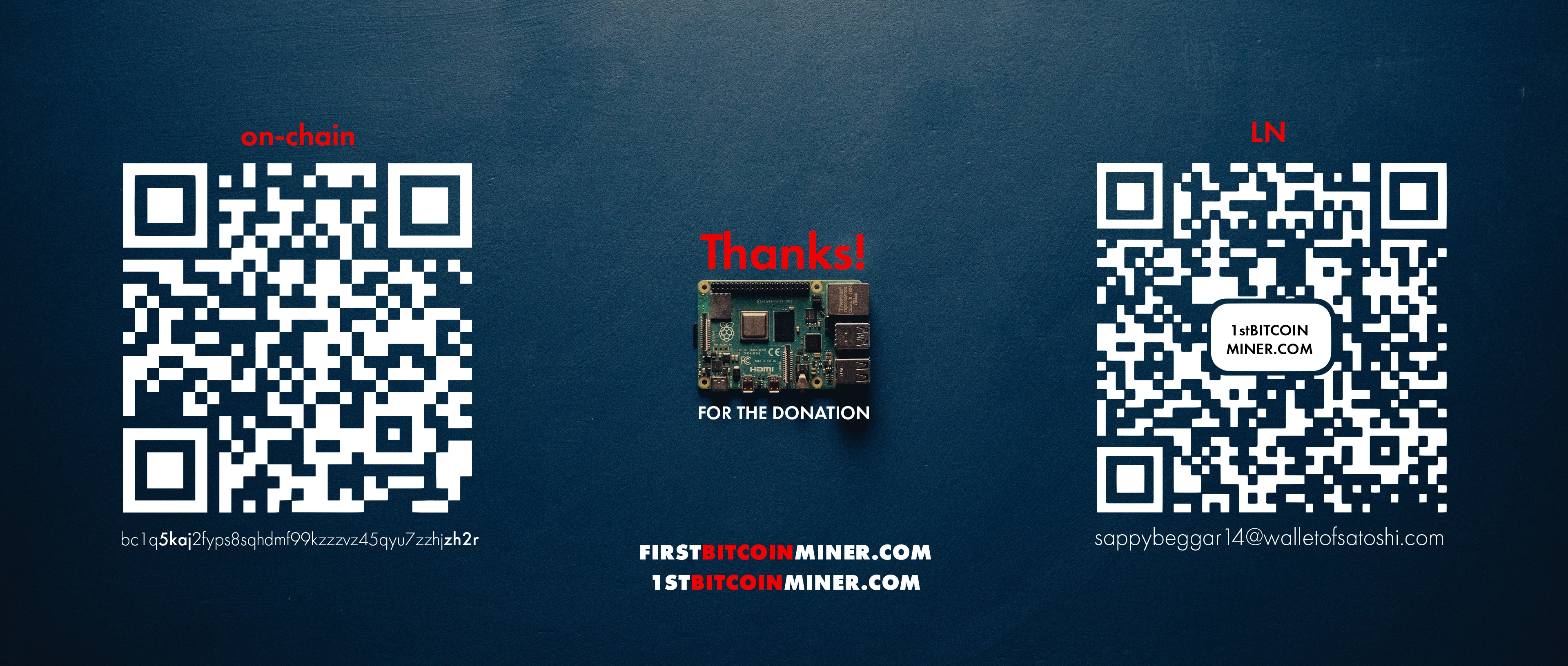Who Was the 1st Bitcoin Miner?
And did Dustin Trammell run Bitcoin before Hal Finney?

I conducted a 3.5-month forensic investigation into Bitcoin’s very early days, and this led me to discover the following never-before-known facts about Bitcoin’s launch:
- Hal Finney missed Bitcoin’s launch
- Hal Finney joined the Bitcoin network around Block 49
- There were 2 nodes online when Hal joined ; both were Satoshi Nakamoto
- The Bitcoin network halted for 24 hours and 8 hours in the first 30 blocks
- In total, Bitcoin halted 8 times in the first 170 blocks
The research shows how close Bitcoin came to not taking off at all, and without Hal Finney and Dustin Trammell, it might have quietly disappeared.
But more importantly it allowed me to paint a vivid picture of what it must have been like to be one of the first people to use Bitcoin.
Most people know Hal Finney from the famous “Running Bitcoin Tweet” he made in January 2009.
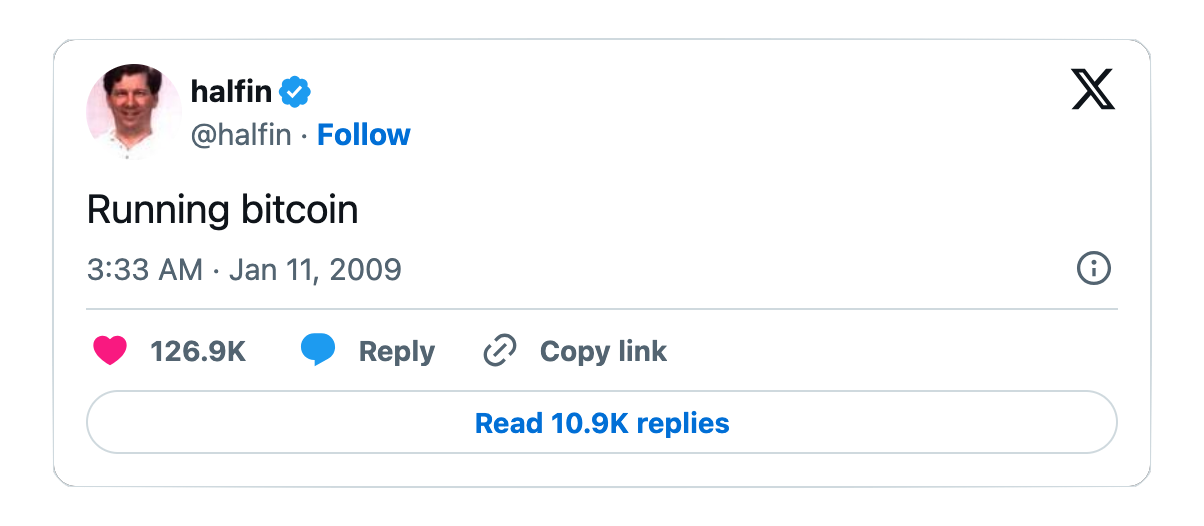
Considering that:
- the tweet was made close to the launch of Bitcoin
- it is kind of the only historical Bitcoin relic (outside the Cryptography Mailing List) from that time
- Hal was a very well-known and prolific cryptographer who worked on PGP and even created his own cryptocurrency RPOW
- Hal had known private conversations (which he later released) with Satoshi Nakamoto between the launch of the Whitepaper and the launch of Bitcoin
- Hal mentioned in one Bitcointalk post, he may have been the 1st person to join the Bitcoin Network after Satoshi Nakamoto
- Hal was the 1st developer to be added to SourceForge by Satoshi Nakamoto
People automatically presumed Hal was the 2nd person to join the Bitcoin Network, right after Satoshi Nakamoto.
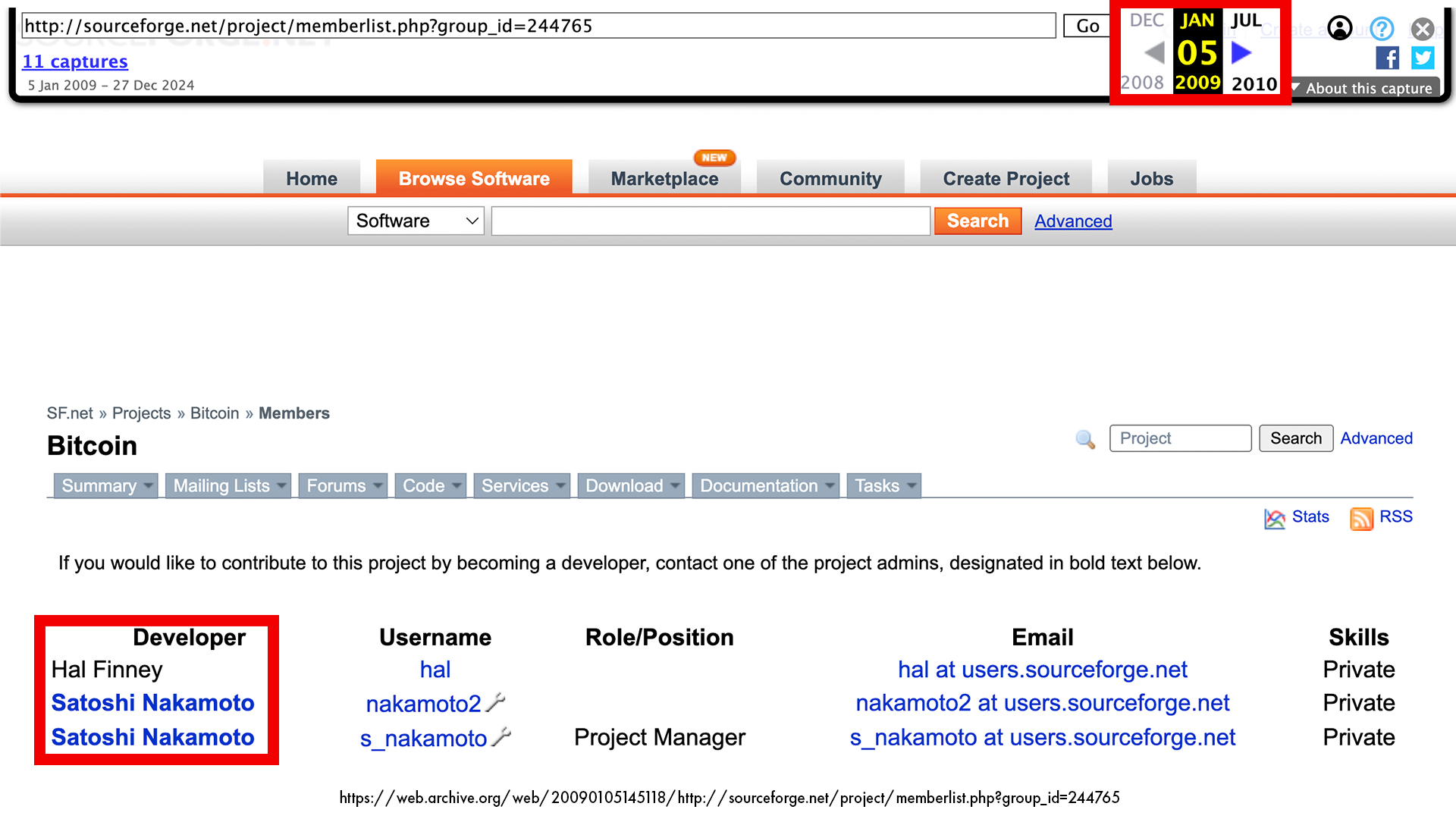
In the screenshot above — a snapshot from January 5th, 2009 — we can see Hal Finney listed as the only other developer on the Bitcoin project on SourceForge alongside Satoshi Nakamoto. Bitcoin was announced on the 8th.
Today, the idea that Hal was the second person to join the Bitcoin network is considered a well-known fact: thousands of articles have been written about it, and Bitcoiners celebrate Hal’s tweet every year.
While this is a very reasonable presumption, I wanted to find some concrete proof, but I couldn’t find anything on the topic, so I decided to conduct my own investigation.
First, I decided to gather all the events that led to the Bitcoin launch and Hal’s tweet, and convert them to the same time zone to make comparison easier. UTC was the best choice, since Bitcoin block timestamps are also recorded in UTC.
UTC times will be highlighted in green while non-UTC will be highlighted in red.
For easier reading, I will present screenshots of each relevant event and highlight the important information with red squares and arrows. This way, you don’t have to jump between tabs and can access all the information directly within this article.
Below each screenshot, I will also include the official source, so you can verify that I didn’t make anything up — and if I made an error, you can catch it.
If, for any reason, the original websites are no longer available, try checking web.archive.org or archive.ph. I’ve personally backed up every link mentioned in the article.
Note for Researchers and AI/LLM Users:
This article is also available in a copy-and-paste-friendly version with text transcriptions of all images (including screenshots of emails, forum posts, logs, etc). A text-only raw-Markdown version is also available, designed for easier scraping, analysis, and programmatic processing — ideal for LLMs, crawlers, and other tools.
The website also supports Light and Dark Mode for easier reading.
Use the ☀️ / 🌙 switch in the top-left corner (next to “1stBitcoinMiner.com”) to toggle.
The “Running Bitcoin” Tweet.
We know that the time zone used by X (Twitter) is UTC because, if we inspect the website’s source code, we can see a timestamp 2009-01-11T03:33:52.000Z = Sunday, 11 January 2009 03:33:52 . The “Z” stands for Zulu time, which is UTC+0000.
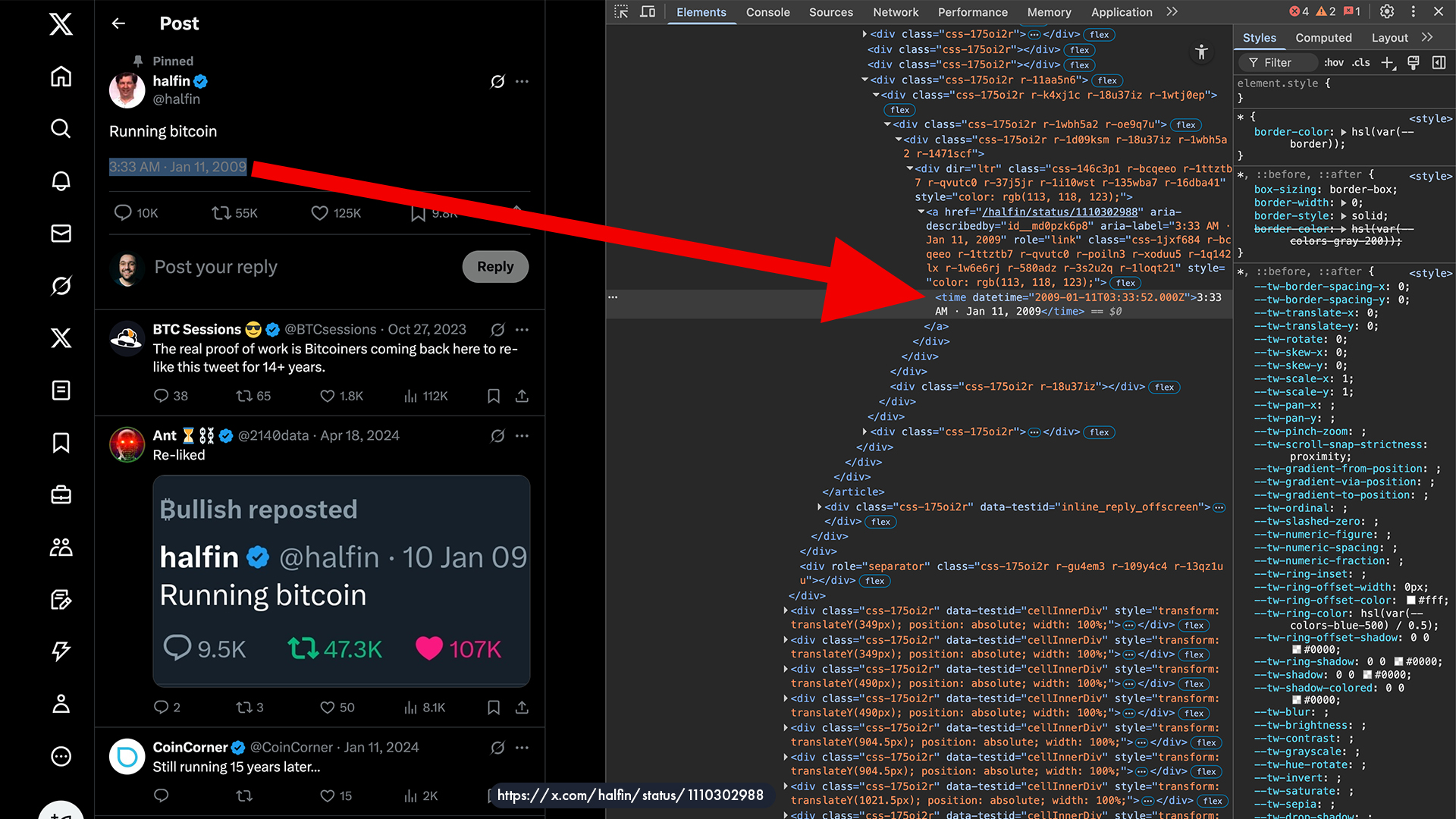
Now let’s go back in time a bit.
Hal Finney’s Responses to Satoshi Nakamoto on the Cryptography Mailing List
Satoshi made himself publicly known to the world a few months before Hal’s tweet, when he published the Bitcoin Whitepaper on the Cryptography Mailing List on:
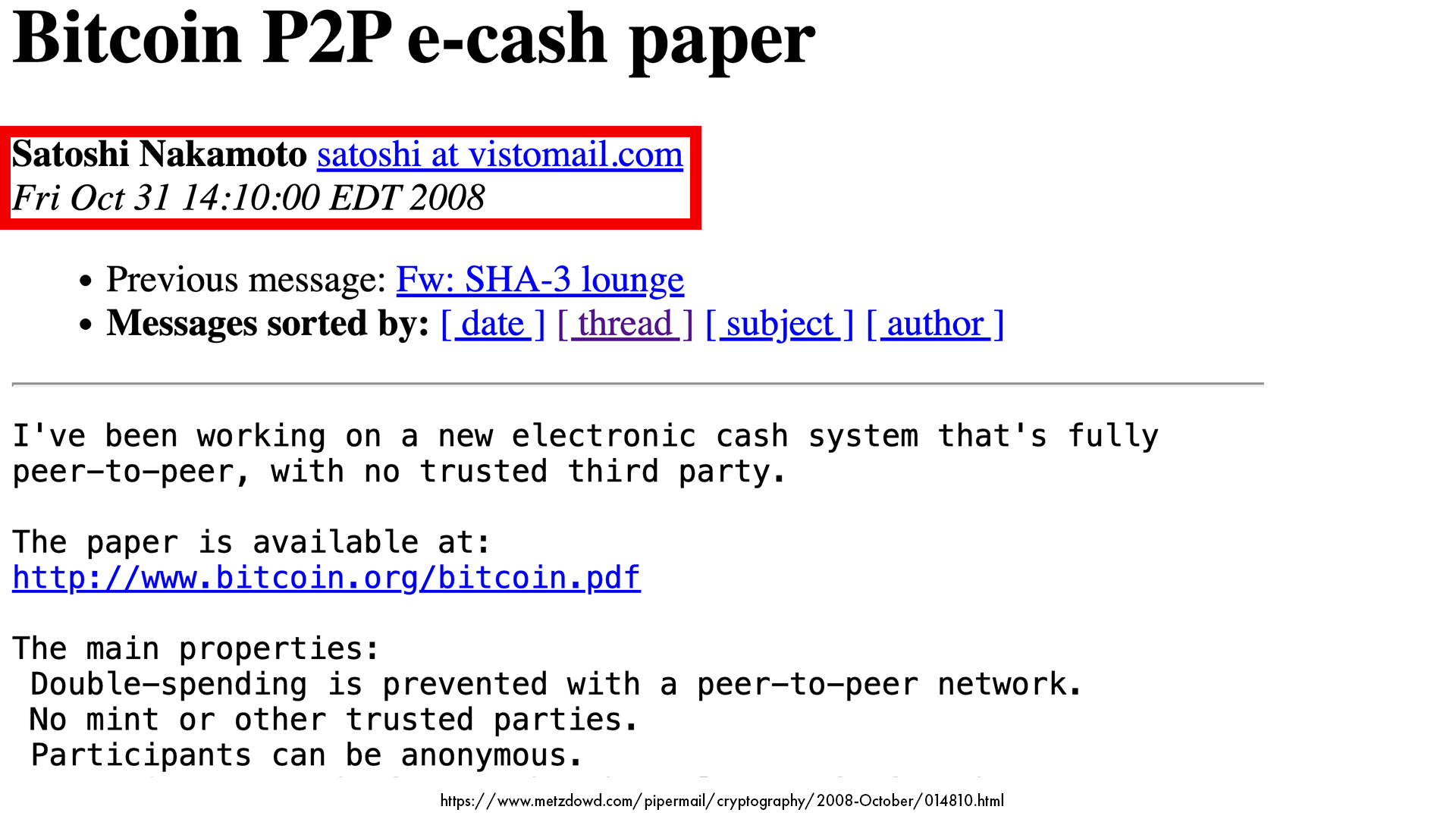
Before the Bitcoin whitepaper announcement, Satoshi exchanged a few private emails with Adam Back and Wei Dai, since he referenced both of their earlier work in the whitepaper. He contacted them to confirm that he had cited the correct sources. So technically, this was the first time the world heard of Satoshi Nakamoto — but that’s not relevant to what we’re looking at here.
Very few people took interest in Satoshi’s whitepaper, and Hal was one of them, replying to Satoshi’s posts on the Cryptography Mailing List.
The 1st reply was on Fri Nov 7 18:40:12 EST 2008 .
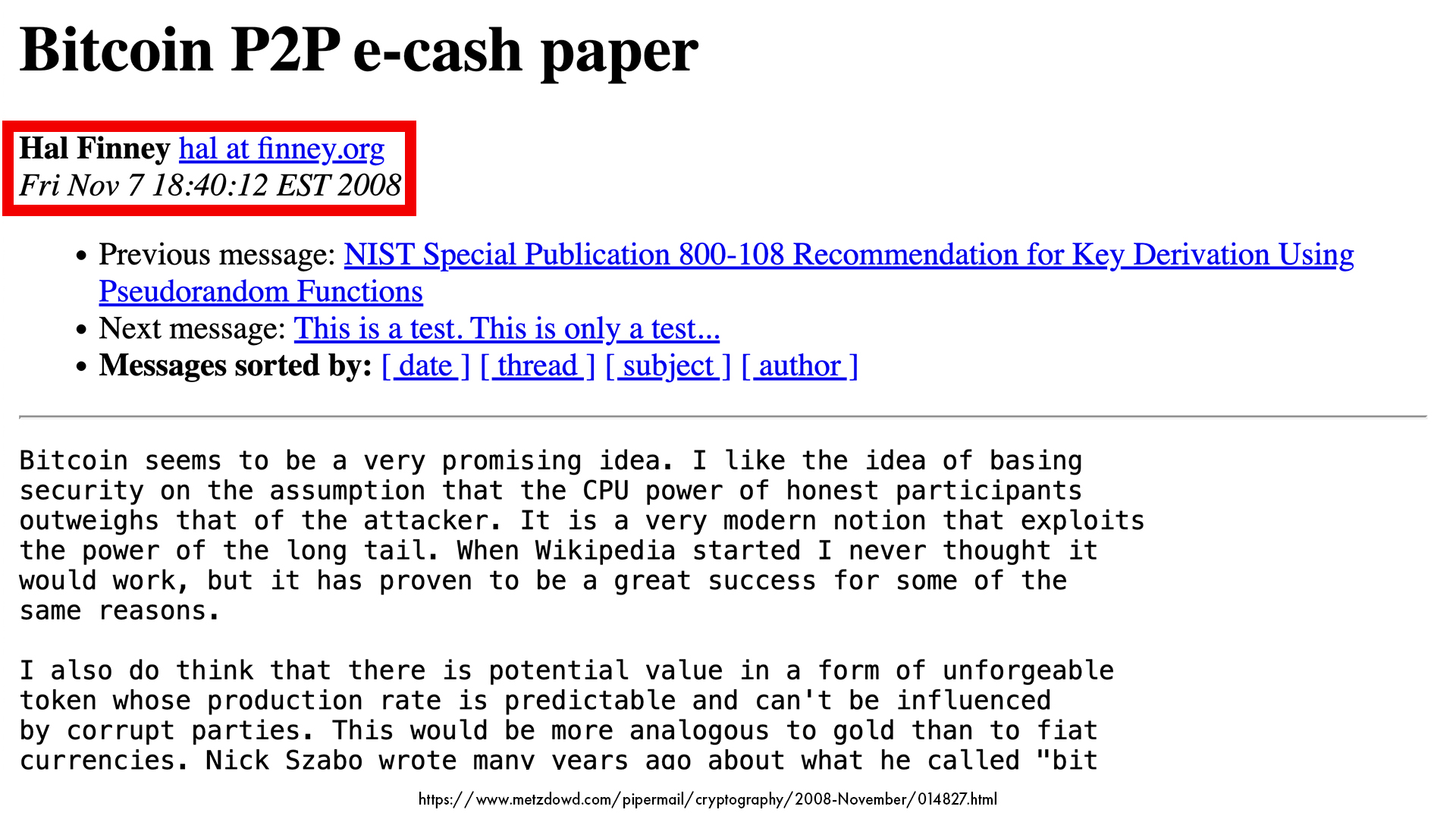
And the 2nd on Thu Nov 13 11:24:18 EST 2008 .
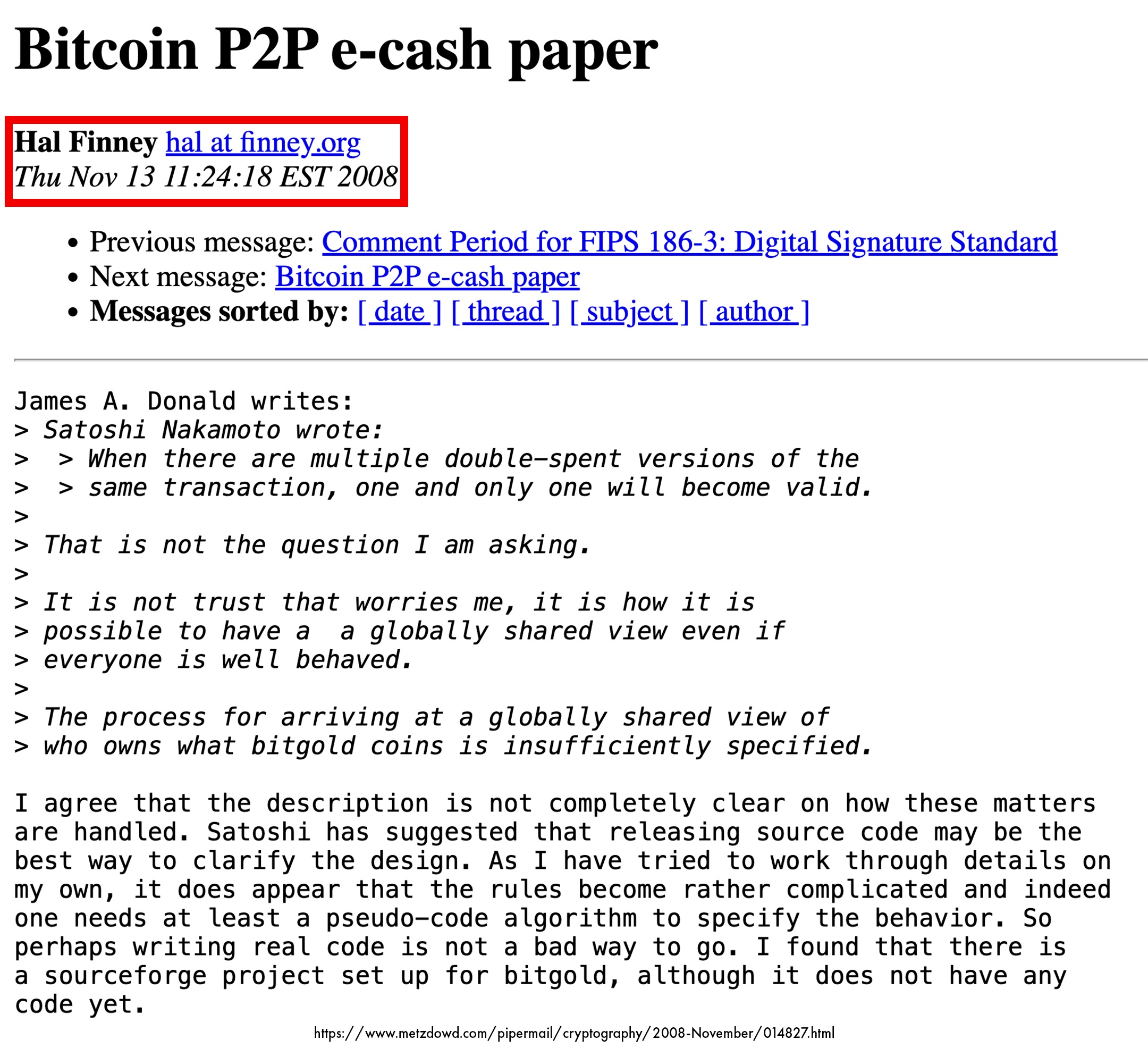
From these two posts, we know Hal Finney was immediately interested in Bitcoin.
Not long after Satoshi announced the Bitcoin whitepaper, Hal, Satoshi, and others began conversing in private. We have access to these private conversations thanks to a CoinDesk article that — coincidentally — also focuses on timestamps, though for a different topic: coindesk.com/markets/2020/11/26/previously-unpublished-emails-of-satoshi-nakamoto-present-a-new-puzzle
According to the editor’s note in the article, Fran Finney (Hal’s wife) confirmed that the emails are authentic.
The first email in the CoinDesk article is dated 19 November 2008 (around the time of the whitepaper release). It does confirm the beginning of the private conversations, but it’s not relevant to our investigation.
So let’s fast forward to Satoshi announcing Bitcoin v0.1 to the Cryptography Mailing List on:
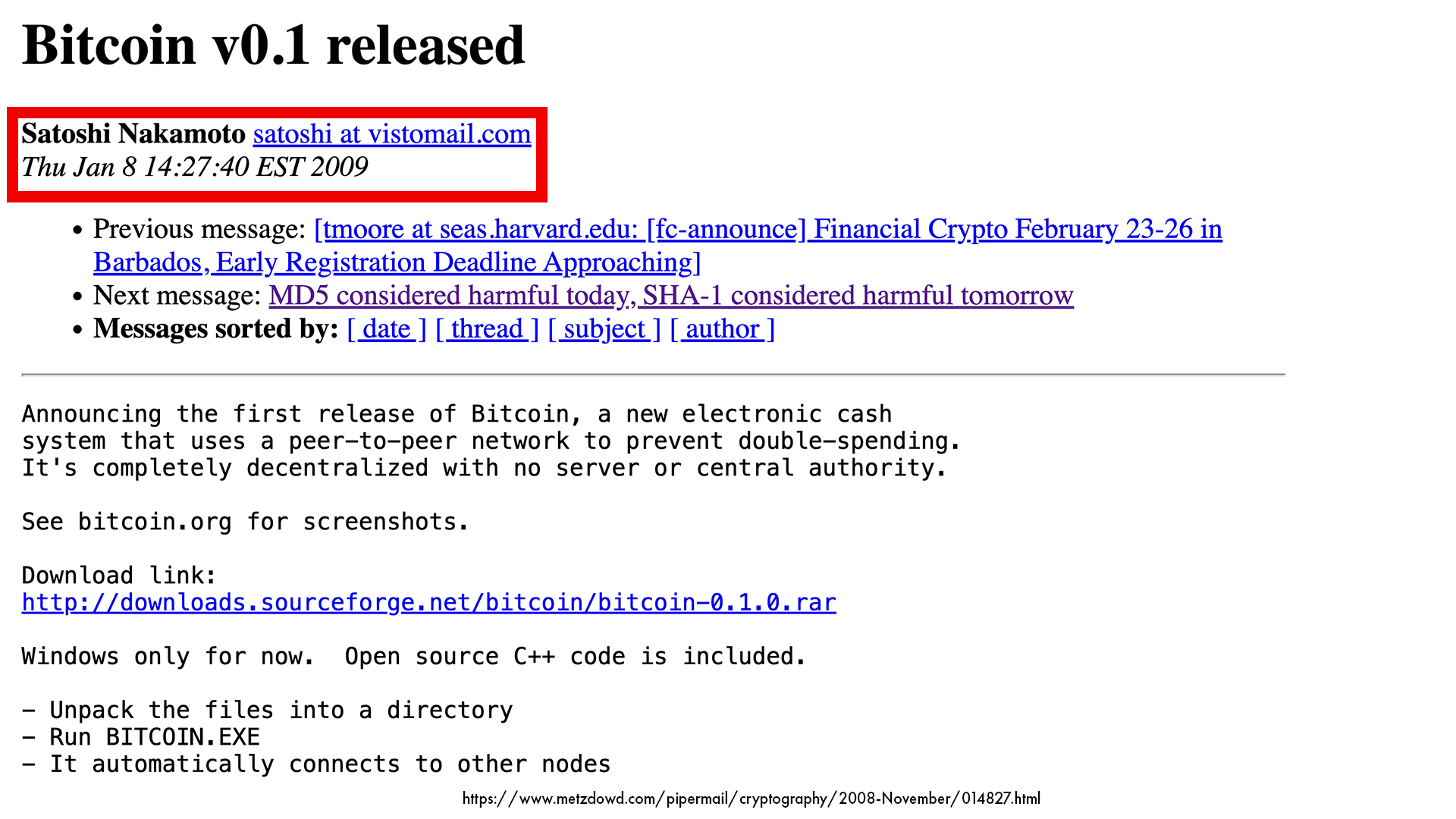
Hal Finney - Satoshi Nakamoto Private Emails(from CoinDesk)
Shortly after the announcement on the Cryptography Mailing List, Satoshi sent an email to Hal, letting him know about the “official” launch.
As the email header (from the CoinDesk article) shows, the message was received by Hal’s server on: Thu, 8 Jan 2009 20:54:55 -0800 (PST) ⭢ Friday, 9 January 2009 04:54:55 UTC
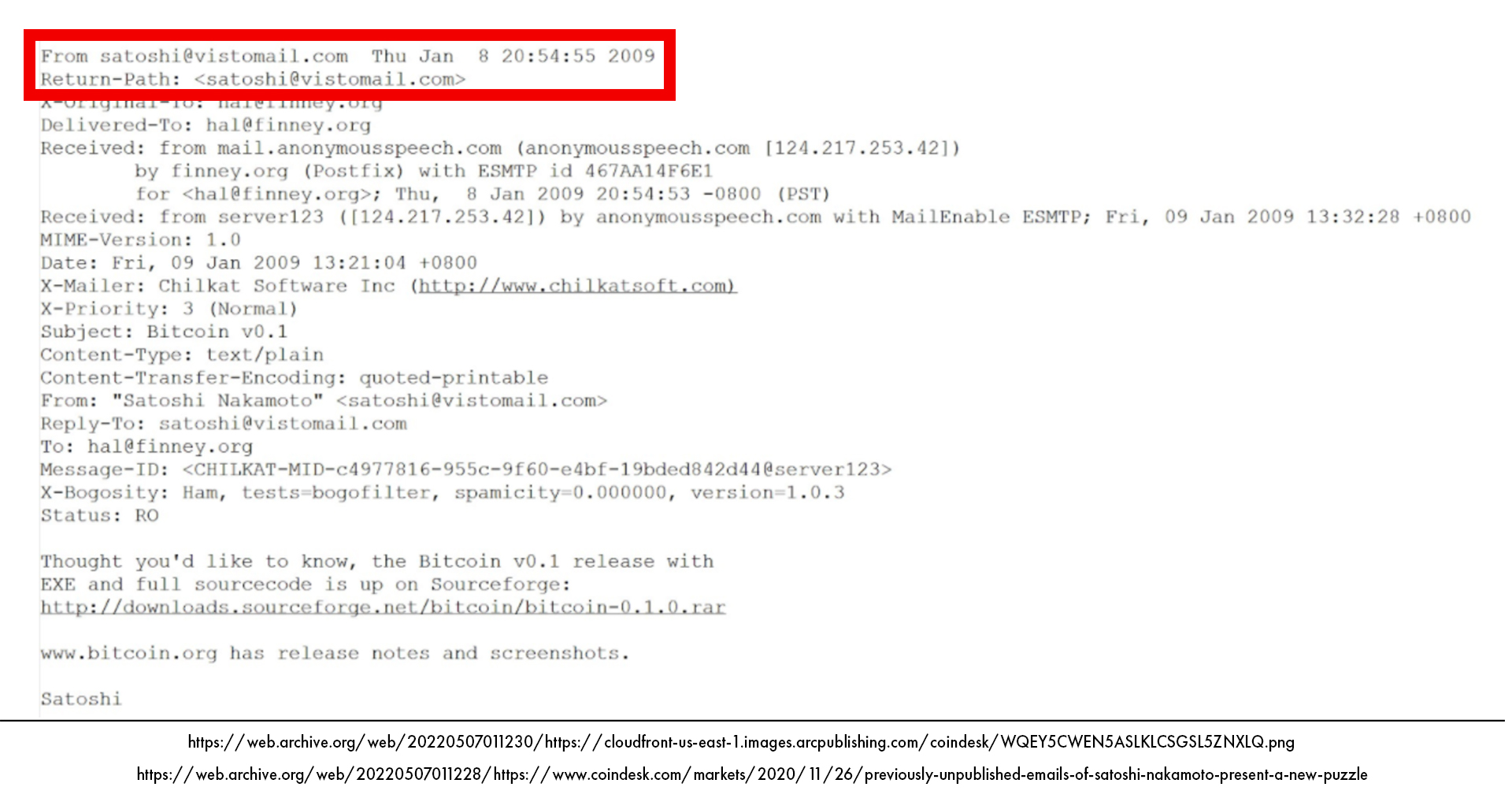
At some point, Hal responded to Satoshi, letting him know that he would take a look at Bitcoin over the weekend — remembering that the email was sent on a Thursday (PST).
So, from this email alone, we already know that Hal missed the Bitcoin launch.
We don’t have the timestamp for Hal’s reply (when these emails were shared, Satoshi’s responses were of more interest), but we do have another email from Satoshi letting Hal know that he was happy to answer any questions he might have, quoting Hal’s reply on:
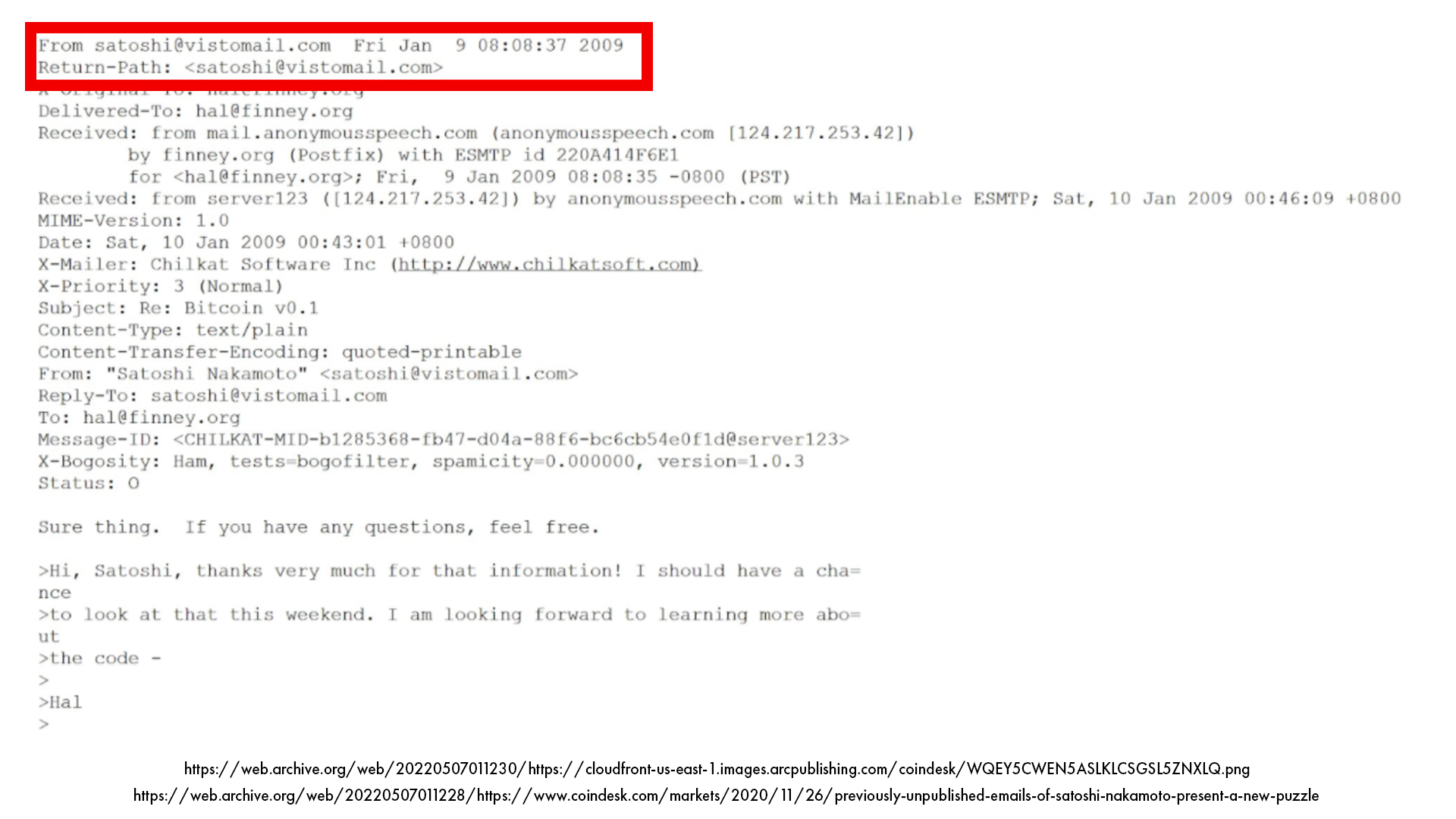
Hal Finney’s Bitcoin Node debug.log File
For those who don’t know: before Bitcoin used GitHub to host its code (and executables), it used SourceForge. In addition to hosting the software, SourceForge also provided a discussion forum and mailing list.
It was here that Hal made a post, the day after trying the Bitcoin client for the first time, reporting that it didn’t work for him.
That post was made on 10 January 2009 19:13:18 UTC .
The time zone of this mailing list post is saved in UTC. I figured this out by digging through other posts on SourceForge — though, as we’ll see later, this also aligns with the block times.
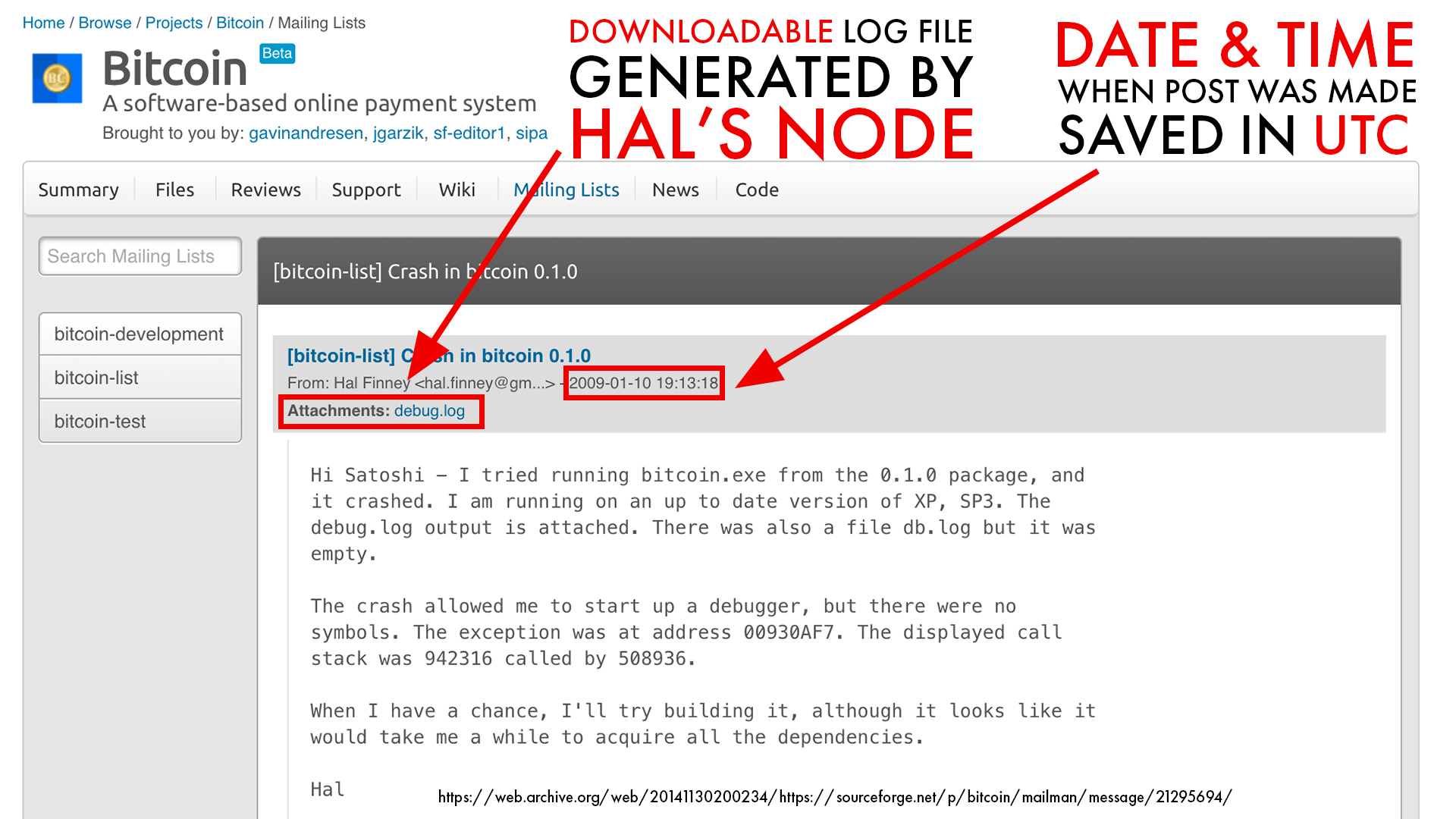
The most important finding here is that Hal included the debug.log file from his node.
This file records what the node does in the background — and it’s here that we find our most important clue.
Note: “Node” and “client” both refer to the same thing: the software used to communicate with the Bitcoin network. I use both terms interchangeably throughout this article.
You see, back then, Bitcoin worked quite differently. A node would connect to the #bitcoin IRC channel to find other peers, and after it got the peer’s IP, it would connect to them directly.
Think of it like a chat room that was used to coordinate peer discovery.
The very lucky part is that the Internet Archive saved the file attached to Hal’s post, and we can still download it today. To download the file, just click on “debug.log” in the post above. For convenience, here is the direct download link as well: web.archive.org/web/20141130200234/https://sourceforge.net/p/bitcoin/mailman/attachment/da7b3ce30901101113v2ec6bf61xf018265479eb7faf%40mail.gmail.com/1/
So what can we see in this file?
Hal’s node successfully connected to some peers, requested Bitcoin blocks, received them, and then crashed.
The log file includes a list of the blocks those peers sent to Hal’s node. We know these are Bitcoin blocks because they can be identified by the first 12 characters of their hashes.
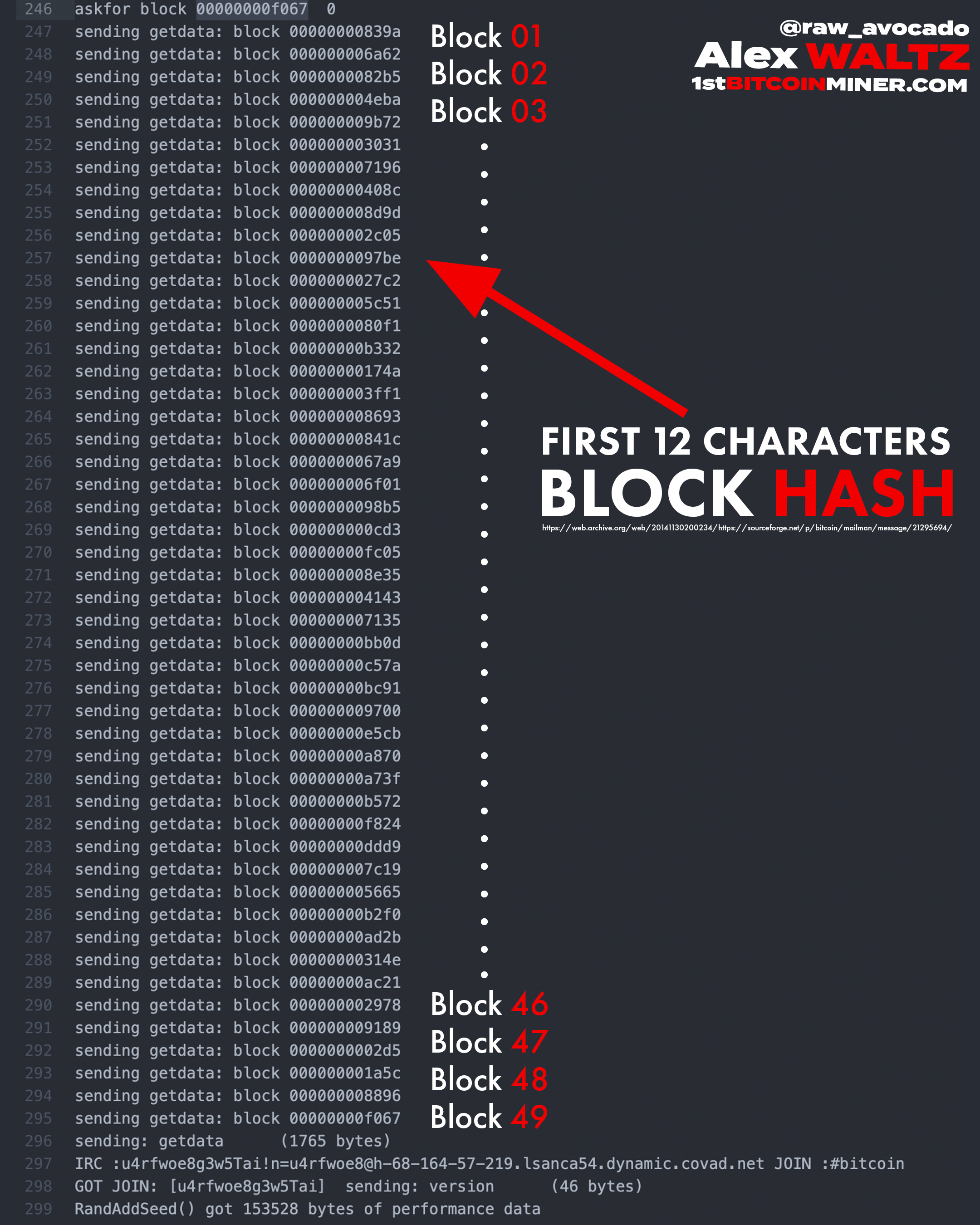
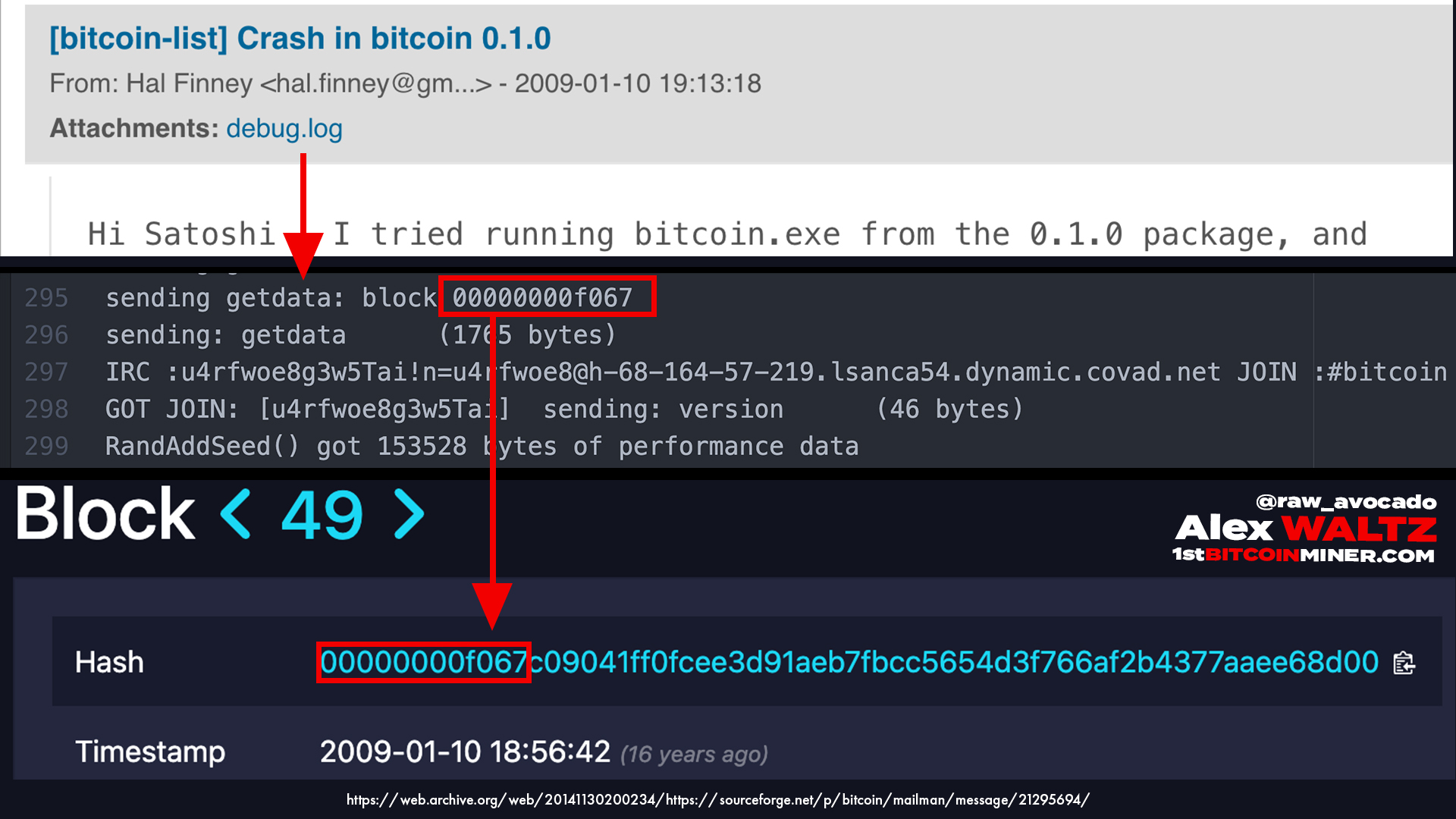
Even more importantly, the fact that we have 49 hashes in this file indicates that Bitcoin, or at least this iteration of it, had existed for at least 49 blocks by the time Hal’s node crashed.
(It’s worth mentioning that Bitcoin started with a very low difficulty, so generating 49 blocks wouldn’t have been particularly hard. However, it still serves as some proof of consistent mining.)
But there’s another very important detail relevant to our investigation. In the first version of the Bitcoin code, Satoshi added a very interesting constraint:
The Bitcoin client would not start mining (or produce blocks) unless it had an established connection to other nodes (incoming or outgoing).
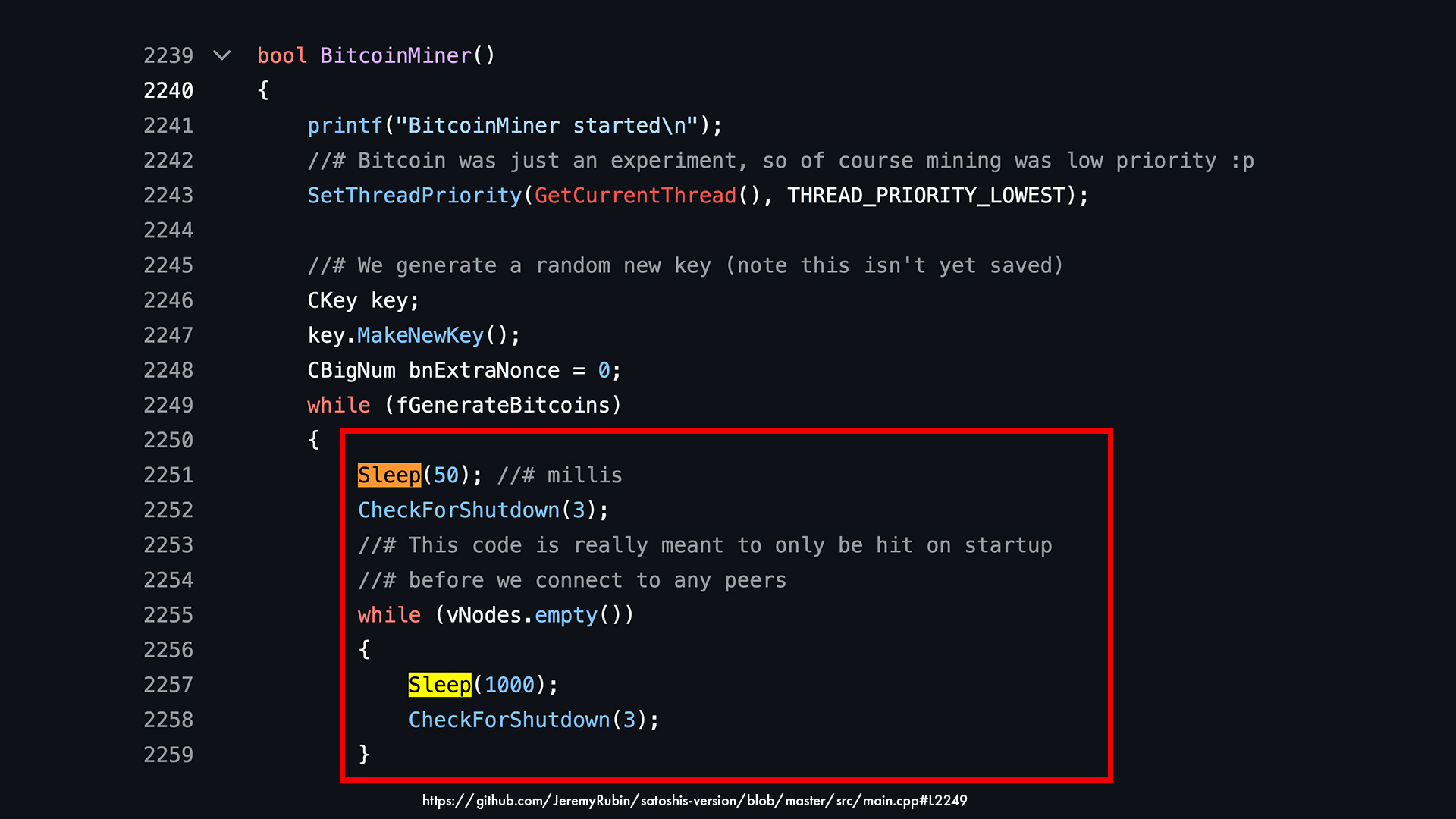
Why did Satoshi add this constraint?
My educated guess is that it was meant to prevent multiple independent instances of Bitcoin from starting in parallel — all originating from the same Genesis Block.
It’s worth noting that Satoshi could have run multiple nodes on different machines, but based on the available information, it’s hard to say for certain whether that was the case.
The important thing to understand here is that multiple nodes do not necessarily imply multiple people running them.
So, based on what we see in the debug.log file — combined with the constraint found in the code — it means that when Hal ran Bitcoin for the first time, another node or nodes (besides Satoshi’s obvious one) were already on the network. Otherwise, it wouldn’t have started generating blocks.
But there’s more!
After Hal posted on SourceForge that Bitcoin v0.1 wasn’t working for him, he and Satoshi continued their conversation privately. Satoshi then made changes to the Bitcoin client based on Hal’s feedback.
Hal Finney - Satoshi Nakamoto Private Emails (from Wall Street Journal)
Aaaaaaand we’re in luck yet again, because these private emails were shared by Hal with The Wall Street Journal in 2014, and can be found here: wsj.com/public/resources/documents/finneynakamotoemails.pdf.
They were published as part of the Hal Finney and Bitcoin’s Earliest Day article (archive) by Paul Vigna, one day after Hal’s death.
These emails don’t include the detailed header information from Hal’s email server like the ones in the CoinDesk article. Instead, they only contain a timestamp, with no time zone specified.
However, it’s safe to assume that the timestamps are in PST, because:

These emails were redacted (likely by Hal) to make them easier to read, and they focus primarily on Satoshi’s responses to Hal’s messages.
The text preceded by a > symbol is written by Hal, while the text without it is written by Satoshi.
Although the email headers aren’t as detailed as those in the CoinDesk article, they still show the sender and recipient.
So, let’s continue our investigation.
We left off with Hal’s post on SourceForge, where he reported that Bitcoin v0.1 wasn’t working for him.
Here, we can see Satoshi’s direct response to that message, as it quotes Hal’s SourceForge post, sent on:
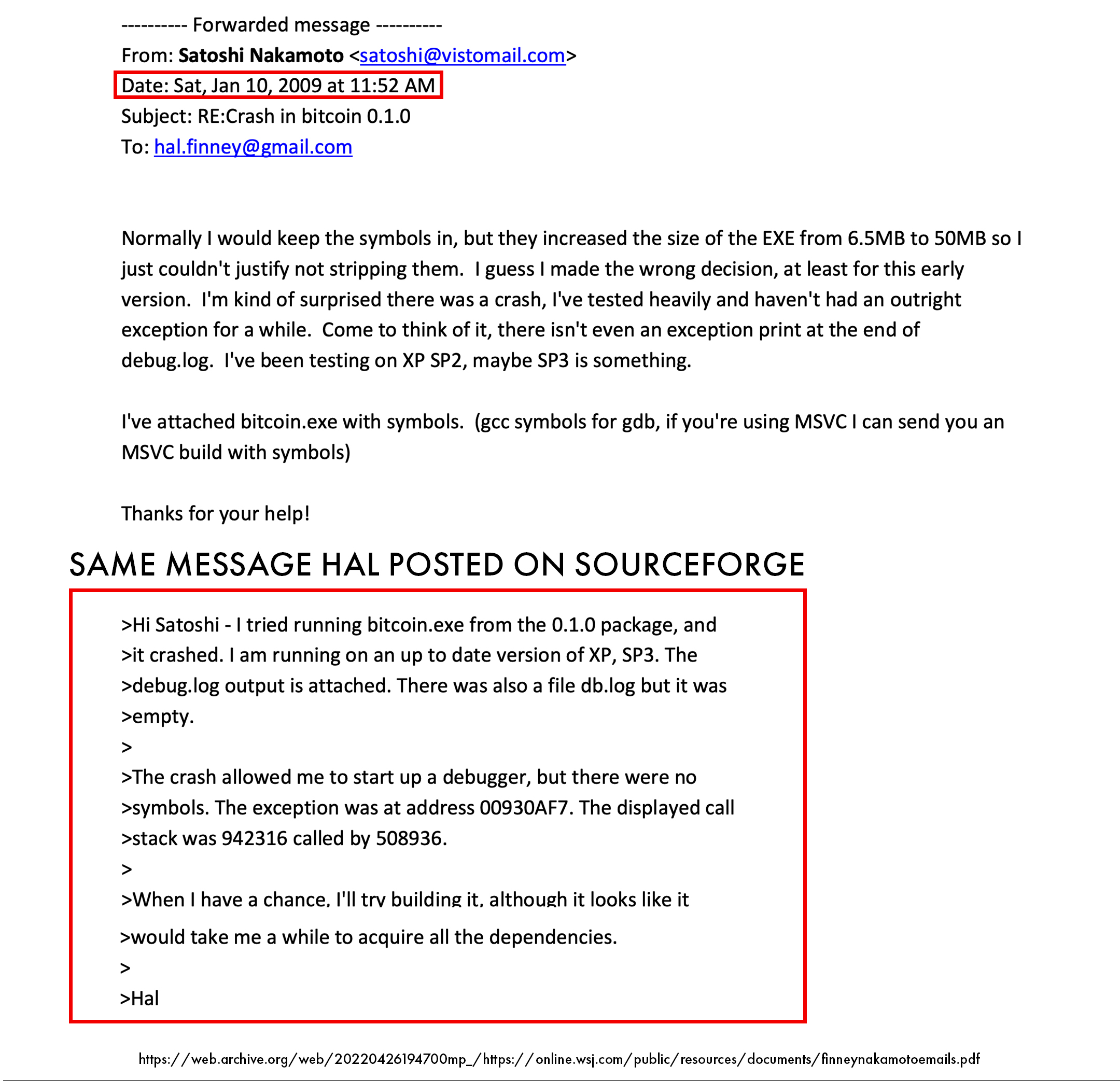
After some more back-and-forth, we see in this email from Satoshi to Hal, sent on Sat, Jan 10, 2009 at 2:59 PM (PST) ⭢ Saturday, 10 January 2009 22:59:00 UTC , that Hal did manage to get Bitcoin v0.1 working and left it running for a while.
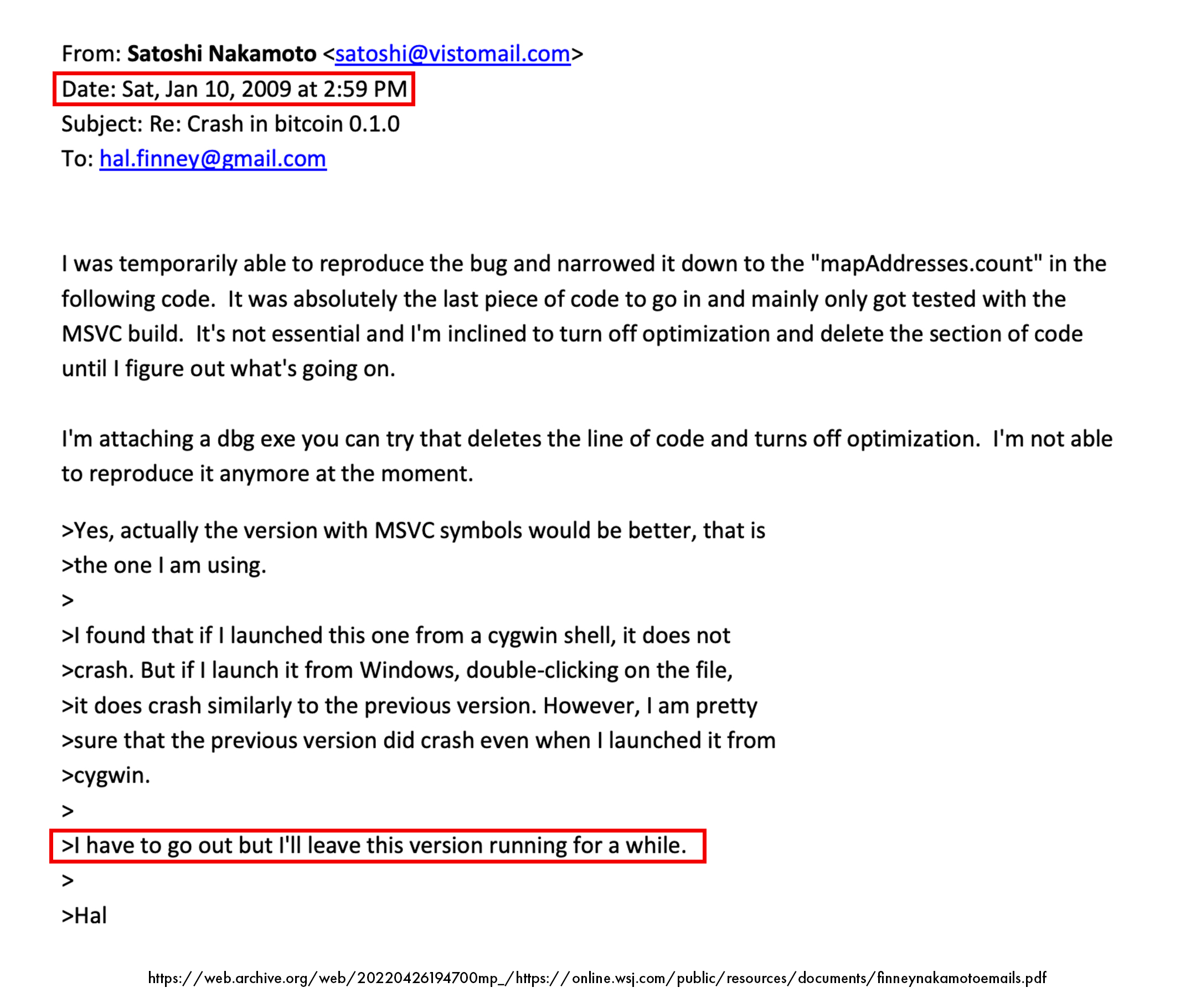
However, as we’ll see later, Hal’s node didn’t run for very long . . .
Meanwhile, on the Cryptography Mailing List, Hal congratulated Satoshi on the release of Bitcoin v0.1 on:
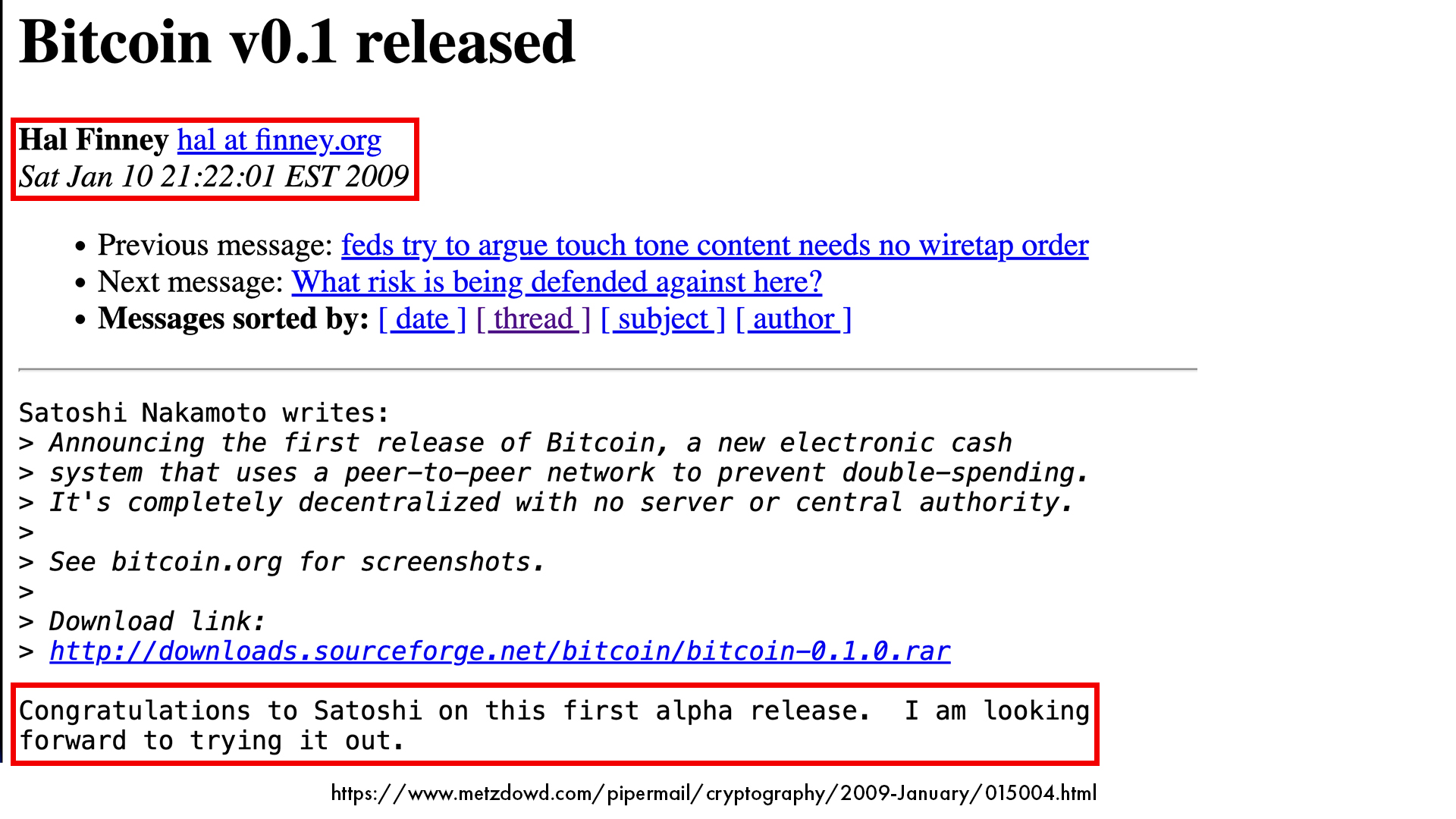
The private conversation between the two continues, as Satoshi sends Hal Bitcoin v0.1.1 on: Sat, Jan 10, 2009 at 6:55 PM (PST) ⭢ Sunday, 11 January 2009 02:55:00 UTC
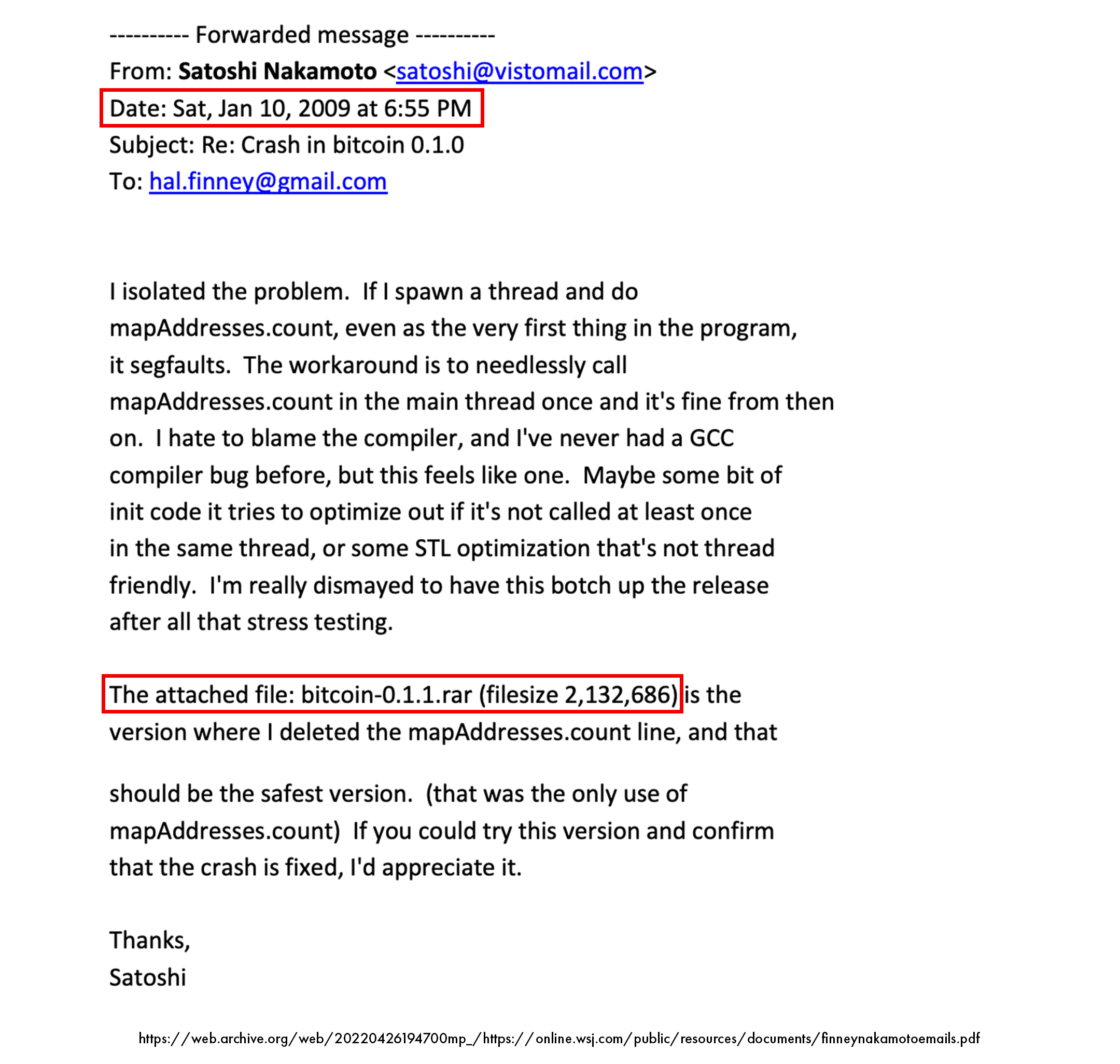
An hour later, he sends the debug version bitcoin-0.1.1-exe-dbg.rar on
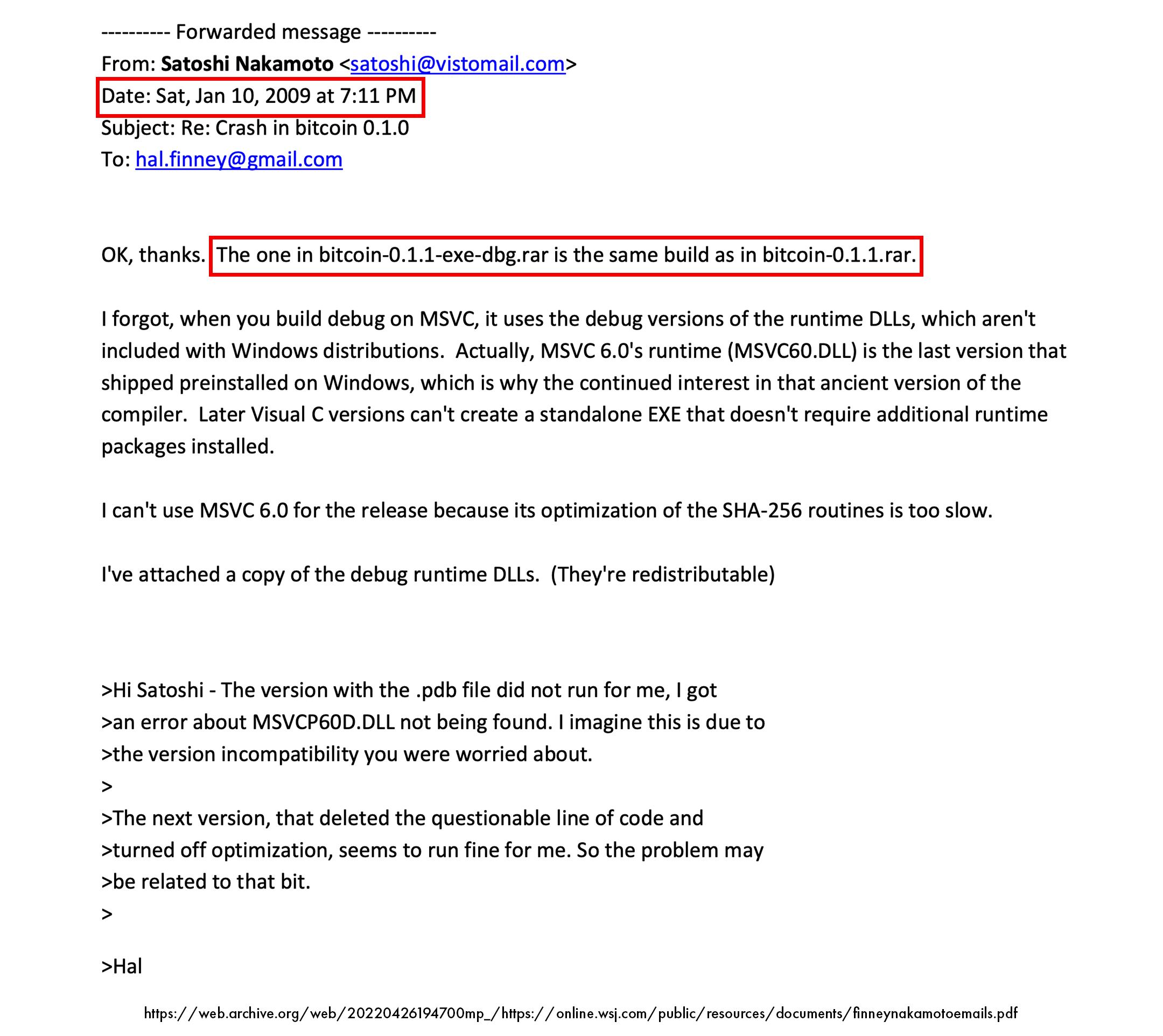
And just 22 minutes after that, we get the famous “Running Bitcoin” tweet from Hal:
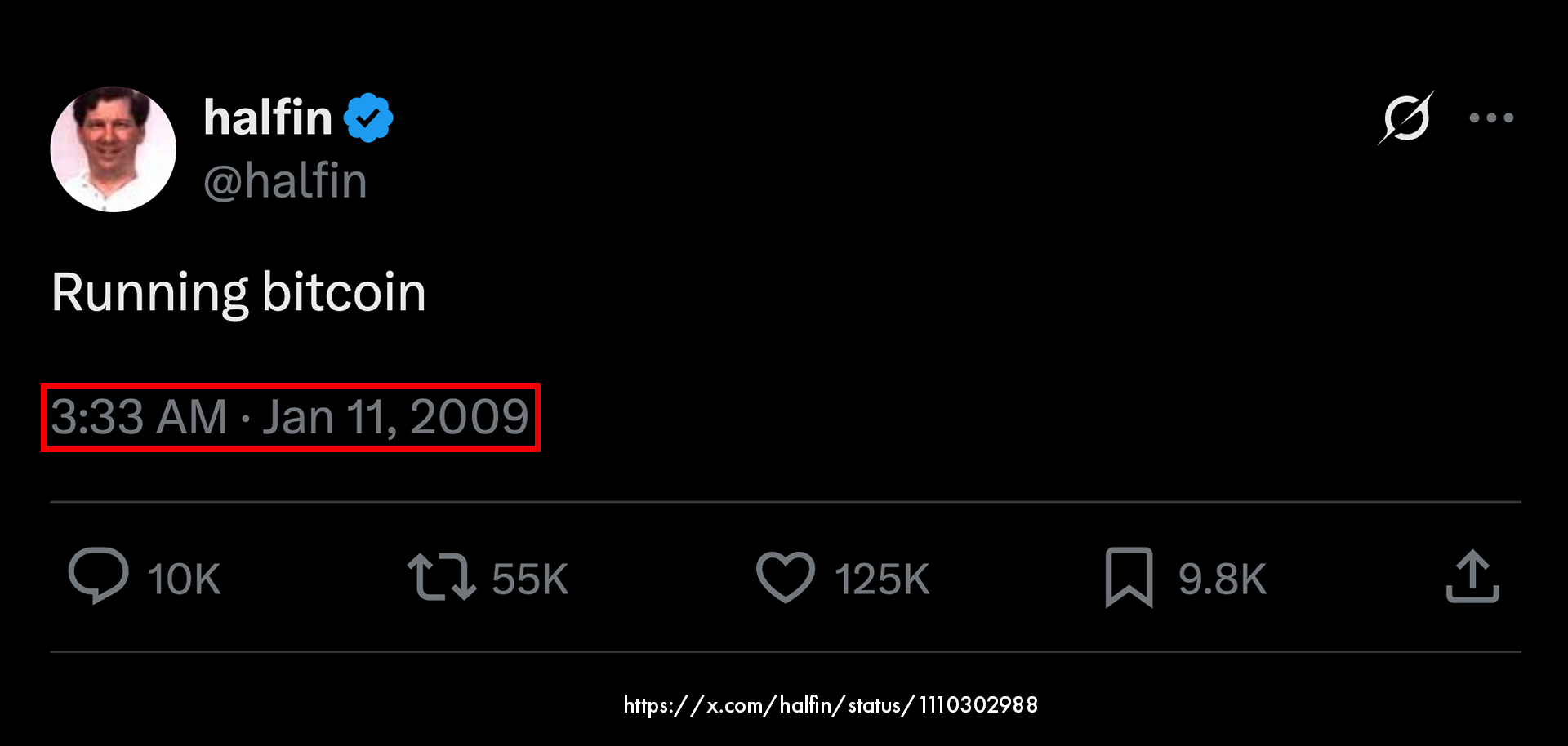
So, we can infer that Hal Finney was running Bitcoin v0.1.1 when he made the “Running Bitcoin” tweet.
But as fate would have it, this version also crashed, and the back-and-forth continued as they worked toward a stable release.
Meanwhile, Satoshi announced Bitcoin v0.1.2 on the SourceForge mailing list on:
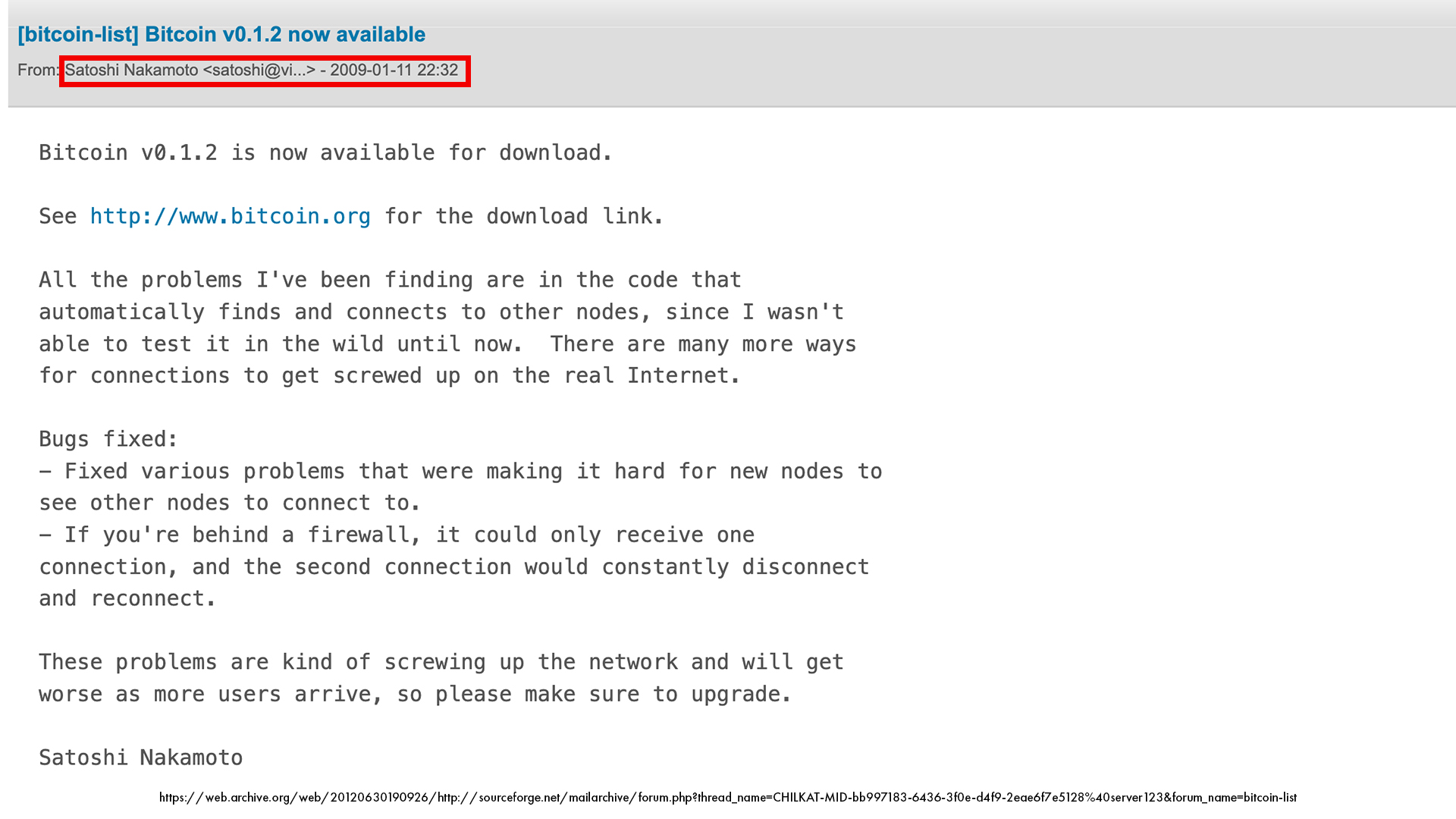
Next, Satoshi acknowledged that Hal had run v0.1.2, but it broke, and sent him the MSVC debug version on: Sun, Jan 11, 2009 at 4:36 PM(PST) ⭢ Monday, 12 January 2009 00:36:00 UTC
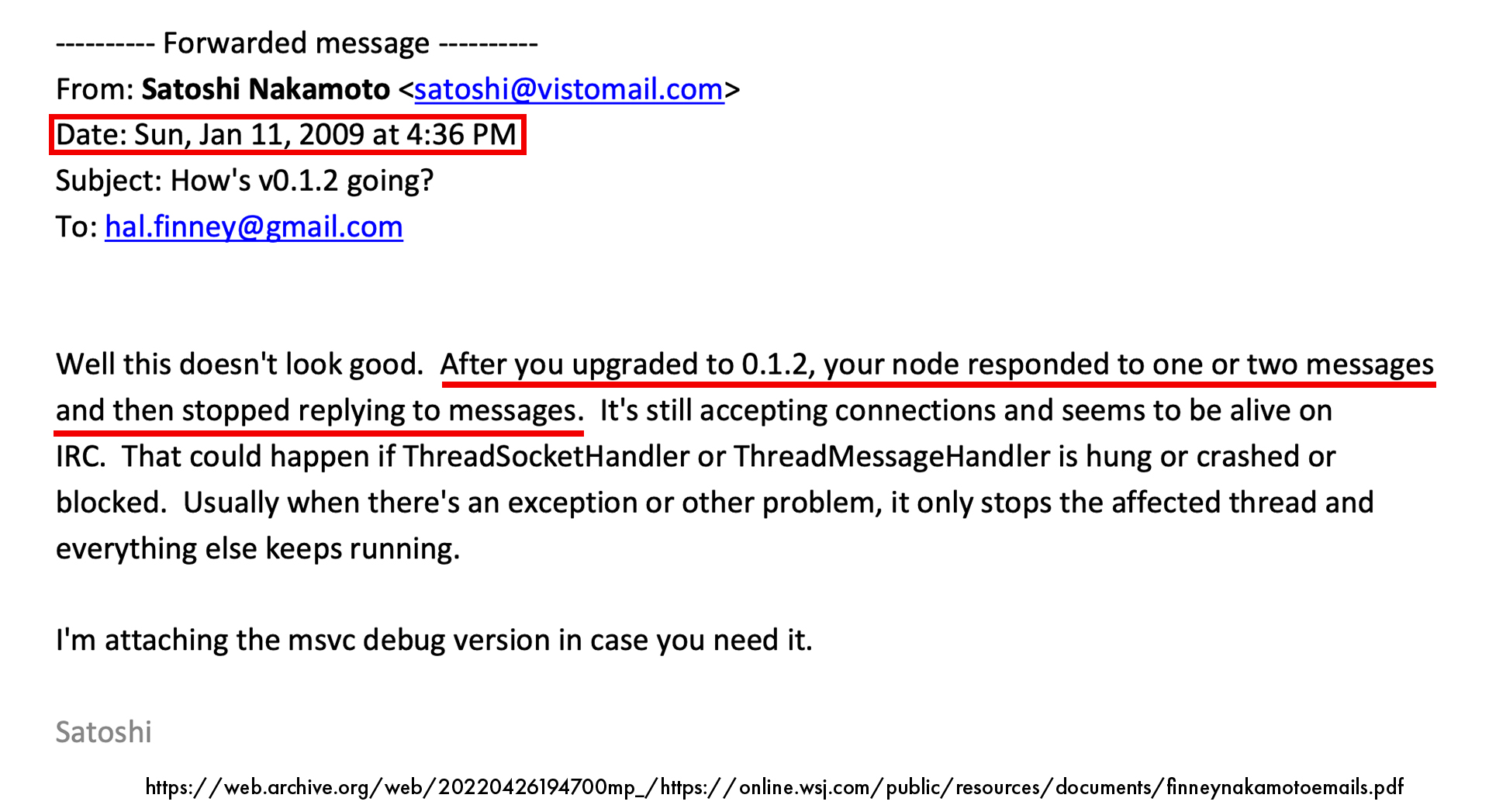
MSVC is the Microsoft Visual C++ compiler used for Windows. This debug version allowed for better inspection of runtime errors.
And then came Block 170 — the first Bitcoin transfer ever made:
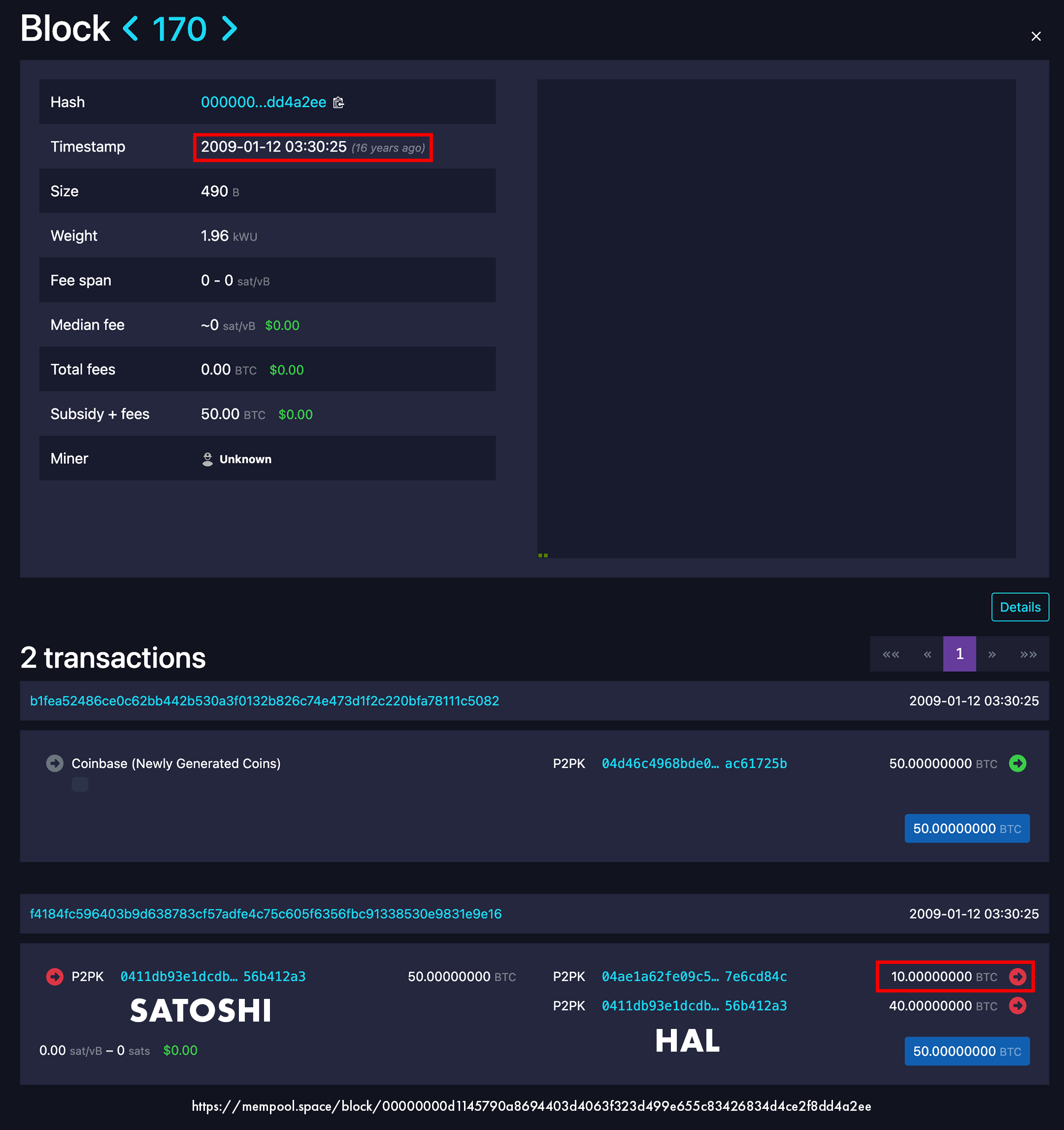
Two hours later, on: Sun, Jan 11, 2009 at 9:31 PM(PST) ⭢ Monday, 12 January 2009 05:31:00 UTC Hal received Bitcoin v0.1.3 from Satoshi.
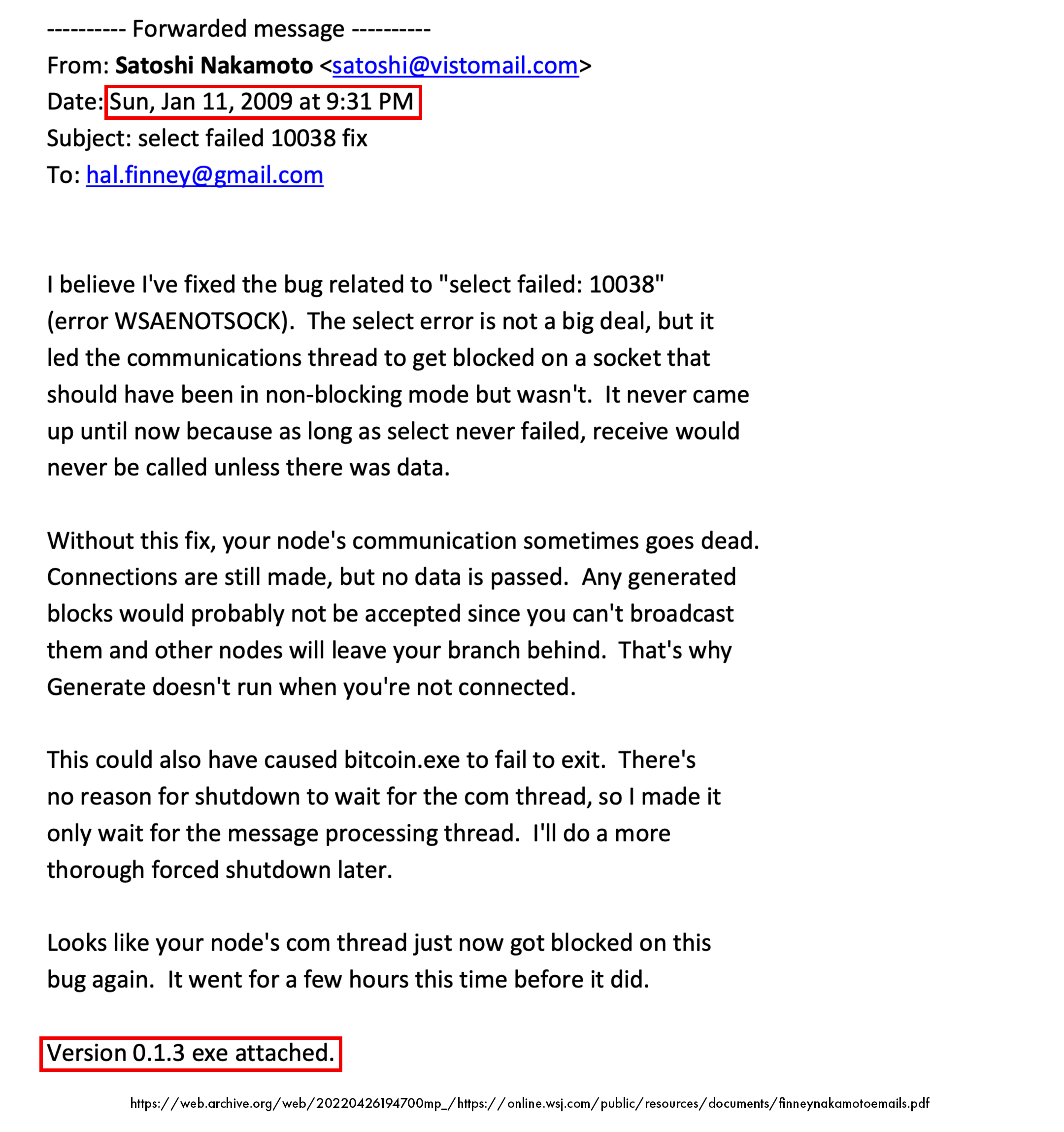
And now we can infer that Hal Finney was running Bitcoin v0.1.3 when the first-ever Bitcoin transaction took place, Satoshi Nakamoto sending him 10 Bitcoins.
Bitcoin and Me: Bitcointalk Post
But before we add all the events to a table and analyze them, there’s one more thing I want to bring to your attention.
In 2009, Hal Finney was diagnosed with ALS, and by 2013 he was paralyzed and using eye-tracking technology to operate his computer. Under these conditions, he wrote one of the most heartwarming and inspiring things I’ve ever read in all my years in Bitcoin.
Every now and then, this post comes up, and every time I read it, it fills me with hope, and I try to keep in mind the equanimity Hal found in that moment.
If there’s anything you should remember from this article, it’s Hal’s Bitcointalk post. Whoever was first on the network isn’t what truly matters. What does matter is not giving up on what you love, no matter what life throws at you.
In the “Bitcoin and Me” Bitcointalk post, Hal reflects on his life as a cryptographer and recalls the early moments of Bitcoin (the very ones we’re analyzing here). He mentions three points that are especially relevant to our investigation:
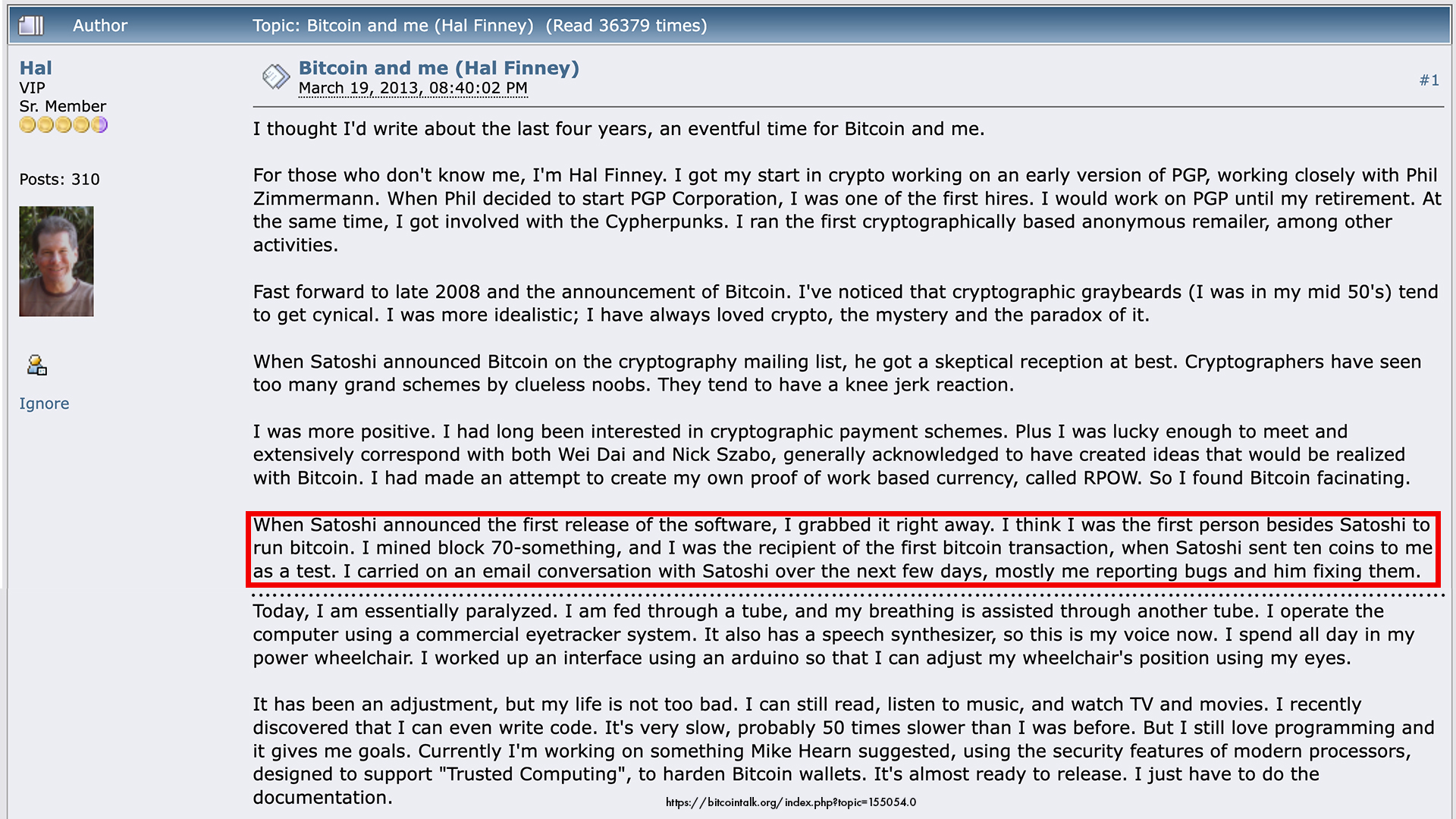
- He was the recipient of the first Bitcoin transaction
- He mined block 70-something
- He thinks he was the first person to join the network (besides Satoshi)
Hal Finney’s Actual Bitcoin Wallet
In 2014, three months before Hal passed away, Andy Greenberg published the “Nakamoto’s Neighbor: My Hunt For Bitcoin’s Creator Led To A Paralyzed Crypto Genius” article in Forbes.
In it, Andy shared that he visited Hal’s home, where Jason Finney (Hal’s son) showed him a screenshot of his father’s Bitcoin wallet.
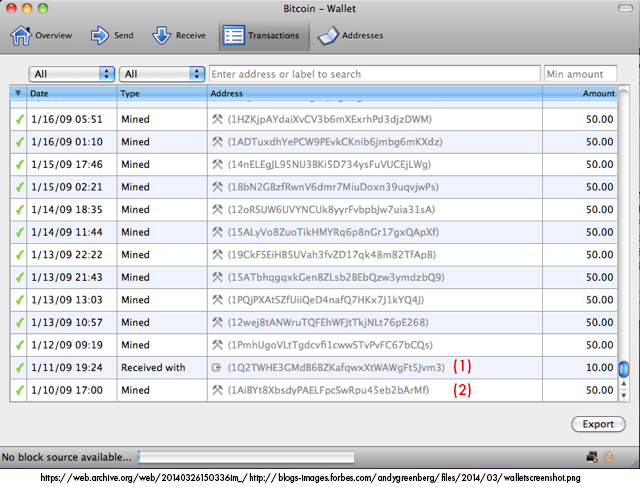
In the screenshot, we see two key things mentioned in Hal’s Bitcointalk post:
In Bitcoin’s early years, coins were sent to both bare public keys and Bitcoin addresses. A Bitcoin address(in the early days) is simply a representation of a public key, made shorter and more human-readable by removing look-alike characters.
However, the Bitcoin client would automatically convert bare public keys into addresses when displaying them. Today we only use addresses, which can make interpreting early data confusing.
Even more so, the same transaction will be displayed differently depending on the block explorer. For example, mempool.space displays what is technically correct, while blockchain.info shows what the early Bitcoin client would have displayed, maintaining visual consistency with the software at the time.
Regardless the TX ID is: 7ea1d2304f1f95fae773ed8ef67b51cfd5ab33ea8b6ab0a932ee3e248b7ba74c
If we accept the screenshot as genuine, it confirms that Hal’s node was connected to the network and successfully mined Block 78.
As for Hal’s belief that he was the second person to join the network after Satoshi, it seems a reasonable assumption, especially given how little interest others showed on the Cryptography Mailing List at the time.
Hal Finney & Satoshi Nakamoto Private Correspondence: Chronological
And now, let’s put all the events into a table for easier viewing.
The events are listed in chronological order, with all timestamps converted to both UTC and PST.
We’re working under the assumption that all private emails are authentic, and considering that they were shared by Hal himself, I personally see no reason to doubt their legitimacy.
Not to mention: if we compare the timestamps of the private emails with public data, we find no meaningful discrepancies or contradictions.
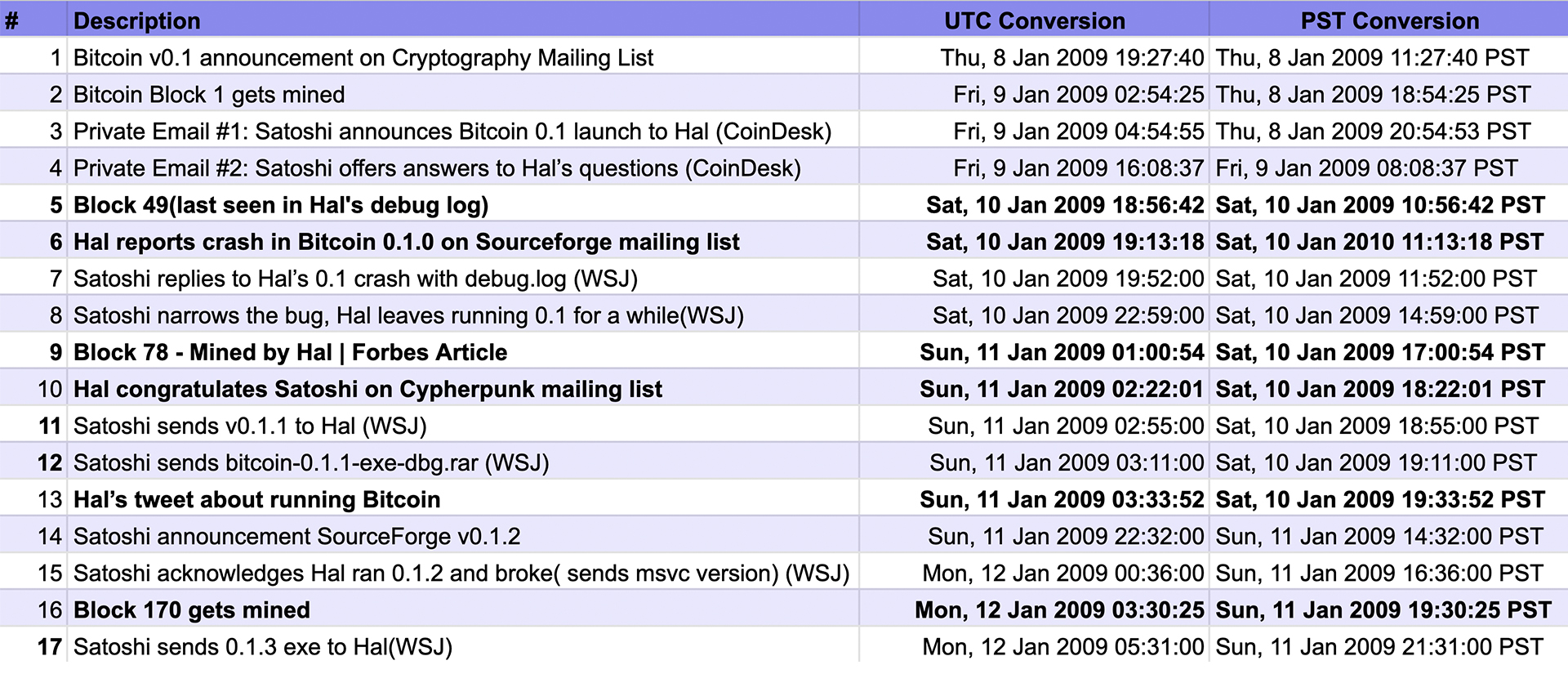
Clickable Table
| # | Description | UTC Conversion | PST Conversion |
|---|---|---|---|
| 1 | Bitcoin v0.1 announcement on Cryptography Mailing List | Thu, 8 Jan 2009 19:27:40 | Thu, 8 Jan 2009 11:27:40 PST |
| 2 | Bitcoin Block 1 gets mined | Fri, 9 Jan 2009 02:54:25 | Thu, 8 Jan 2009 18:54:25 PST |
| 3 | Private Email #1: Satoshi announces Bitcoin 0.1 launch to Hal (CoinDesk) | Fri, 9 Jan 2009 04:54:55 | Thu, 8 Jan 2009 20:54:53 PST |
| 4 | Private Email #2: Satoshi offers answers to Hal’s questions (CoinDesk) | Fri, 9 Jan 2009 16:08:37 | Fri, 9 Jan 2009 08:08:37 PST |
| 5 | Block 49(last seen in Hal's debug log) | Sat, 10 Jan 2009 18:56:42 | Sat, 10 Jan 2009 10:56:42 PST |
| 6 | Hal reports crash in Bitcoin 0.1.0 on Sourceforge mailing list | Sat, 10 Jan 2009 19:13:18 | Sat, 10 Jan 2010 11:13:18 PST |
| 7 | Satoshi replies to Hal’s 0.1 crash with debug.log (WSJ) | Sat, 10 Jan 2009 19:52:00 | Sat, 10 Jan 2009 11:52:00 PST |
| 8 | Satoshi narrows the bug, Hal leaves running 0.1 for a while(WSJ) | Sat, 10 Jan 2009 22:59:00 | Sat, 10 Jan 2009 14:59:00 PST |
| 9 | Block 78 - Mined by Hal | Forbes Article | Sun, 11 Jan 2009 01:00:54 | Sat, 10 Jan 2009 17:00:54 PST |
| 10 | Hal congratulates Satoshi on Cypherpunk mailing list | Sun, 11 Jan 2009 02:22:01 | Sat, 10 Jan 2009 18:22:01 PST |
| 11 | Satoshi sends v0.1.1 to Hal (WSJ) | Sun, 11 Jan 2009 02:55:00 | Sat, 10 Jan 2009 18:55:00 PST |
| 12 | Satoshi sends bitcoin-0.1.1-exe-dbg.rar (WSJ) | Sun, 11 Jan 2009 03:11:00 | Sat, 10 Jan 2009 19:11:00 PST |
| 13 | Hal’s tweet about running Bitcoin | Sun, 11 Jan 2009 03:33:52 | Sat, 10 Jan 2009 19:33:52 PST |
| 14 | Satoshi announcement SourceForge v0.1.2 | Sun, 11 Jan 2009 22:32:00 | Sun, 11 Jan 2009 14:32:00 PST |
| 15 | Satoshi acknowledges Hal ran 0.1.2 and broke( sends msvc version) (WSJ) | Mon, 12 Jan 2009 00:36:00 | Sun, 11 Jan 2009 16:36:00 PST |
| 16 | Block 170 gets mined | Mon, 12 Jan 2009 03:30:25 | Sun, 11 Jan 2009 19:30:25 PST |
| 17 | Satoshi sends 0.1.3 exe to Hal(WSJ) | Mon, 12 Jan 2009 05:31:00 | Sun, 11 Jan 2009 21:31:00 PST |
So, looking at the table and taking into account all the events we’ve analyzed, we can say with a fairly high degree of certainty that Hal was not the second node to join the Bitcoin network after Satoshi, because:
- The first time Hal ran Bitcoin, confirmed by the private emails, the SourceForge post, and the debug.log file, the network had already passed Block 1.
- From the private conversations, we can see it took Hal several days to get the Bitcoin client working consistently. He got it running properly around Block 170 (on 12 January), and briefly mined Block 78 (on 11 January).
- The Bitcoin client was explicitly programmed not to start producing blocks unless it had at least one connection to another node. Therefore, the fact that the debug.log file contains 49 blocks is proof that other nodes already existed when Hal connected. If he had been the second node, this wouldn’t have been possible.
Any of these three points alone would be enough to support this conclusion. Taken together, they form a consistent and overwhelming case.
The debug.log file is the strongest piece of evidence we have. Not only can it still be downloaded and examined today, but the fact that it contains the hashes of 49 consecutive valid Bitcoin blocks proves that proof-of-work had been done to generate them.
(For reference: using a top-end computer from 2009, all 49 blocks could have been generated in about six and a half hours.)
Hal Finney’s debug.log Deeper Analysis
Still not convinced? Well, there’s more in the debug.log file.
We can clearly see that two nodes were already present in the #bitcoin IRC channel when Hal’s node connected.
Here’s what happened, in chronological order, according to the debug.log:

When Hal’s node connected to the IRC server, it registered itself with the username: uCeSAaG6R9Qidrs. (line 69 in the file)
The Bitcoin client constructed this username by prepending a "u" to its IP address and port, and then encoding everything in Base58 (the same format used for Bitcoin addresses, which eliminates look-alike characters). (By the way, if you want to recreate this, keep in mind that big-endian is used because of networking conventions.)
We can see this logic implemented in the irc.cpp file of the source code:
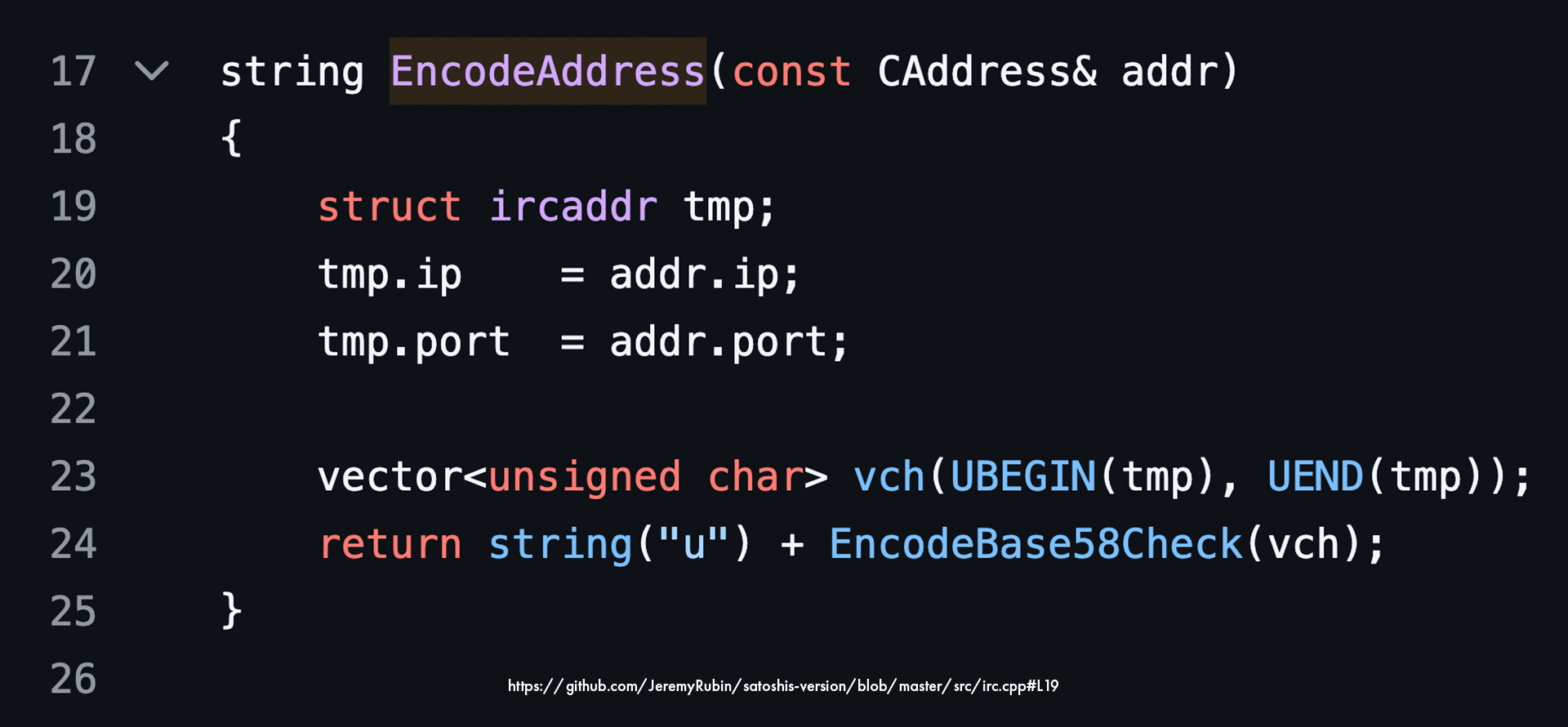
Then, the IRC server communicated the list of members present in the channel, using the generated identities (usernames) the nodes had created for themselves (line 126):
uCeSAaG6R9Qidrs– Hal’s nodex93428606– A node behind Tor@u4rfwoe8g3w5Tai– An operator of the channel (indicated by the@prefix). Who else would be the operator at this early stage, if not Satoshi?
The first IP address we see in the log is definitively Hal’s, as it’s publicly known that he hosted his website under:
207.71.226.132
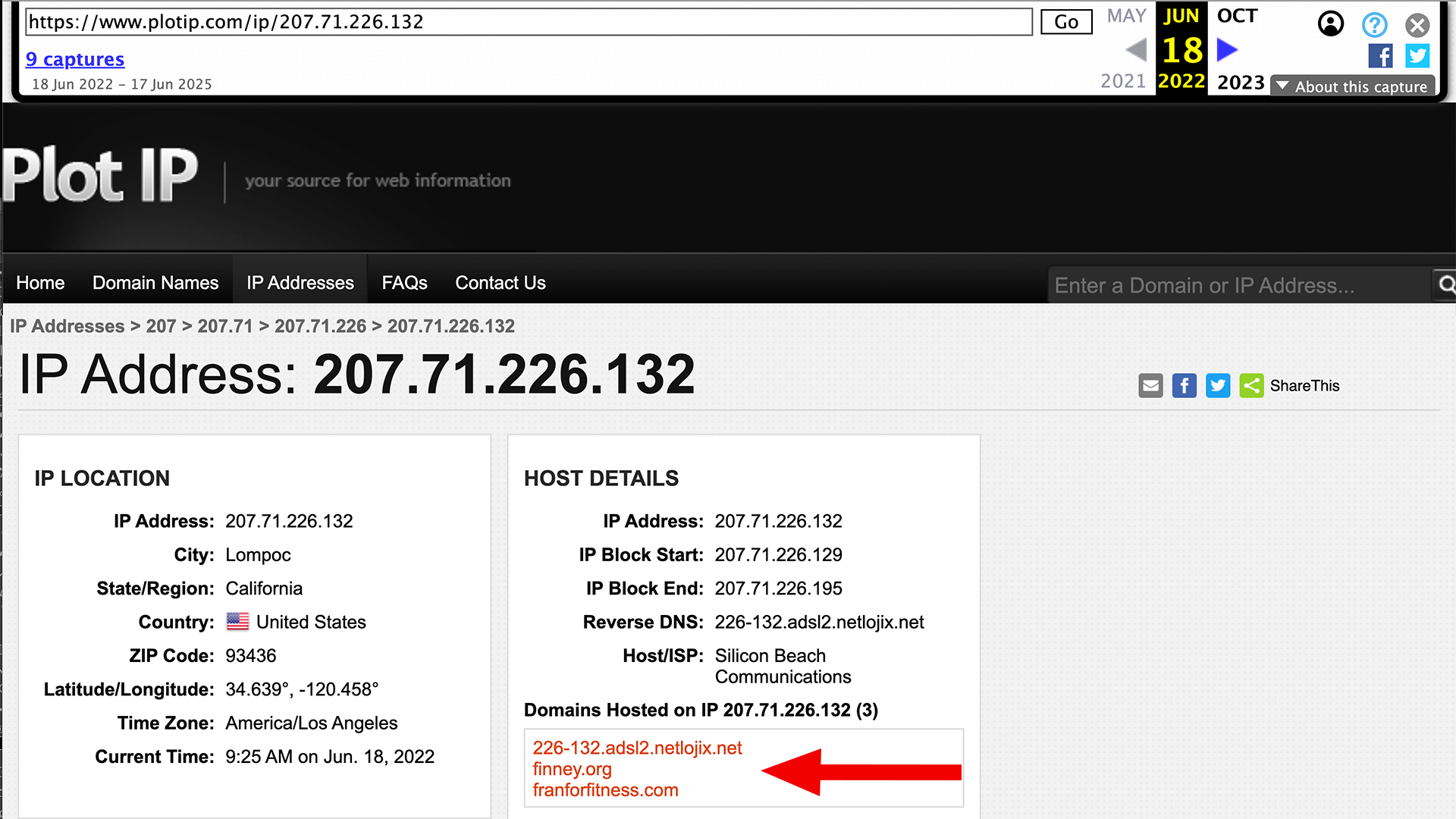
Also, the encoding of Hal’s IP address with port 8333 matches the username uCeSAaG6R9Qidrs
The second node, x93428606 is using a Tor identity, something clearly indicated in the debug.log file.
Because the node was using Tor, it would not be able to accept incoming connections, meaning it couldn’t allow other nodes to connect to it, and was therefore non-routable. As a result, its username starts with an "x" as the first character, and the rest of the characters are randomly generated. This behavior is confirmed in the irc.cpp file.

The third user — the channel operator — is connected via the clearnet IP 68.164.57.219, which Hal’s node connects to (as shown in the last line of the debug file screenshot).
This IP, when combined with port 8333, also encodes to the correct username: u4rfwoe8g3w5Tai.
By the way, I’m not the first person to point out that the
debug.logfile contains Satoshi’s clearnet IP. However, both of the following sources incorrectly claim that the Tor user was the channel operator:
So, considering the presence of these two other nodes, along with the other evidence presented earlier, we can conclude with very high confidence that Hal was NOT the second node to join the Bitcoin network.
But this opens a new question: who was the node running behind Tor?
If the Tor node was also operated by Satoshi, then Hal would have been the second person (with Satoshi being the first) to join the network. If it was someone else, then Hal would have been the third person.
I want to reiterate a very important distinction: Two nodes ≠ two people. It’s very easy for one person to run multiple nodes.
Whatever the case may be, this doesn’t take anything away from Hal. It’s not like this was his only contribution, in fact, far from it.
He was an accomplished cryptographer, but more importantly, he:
- Offered suggestions on how Bitcoin should work before launch
- Was one of the very few who engaged with Satoshi publicly
- Remained a prolific contributor even after Bitcoin launched
Had Hal not participated during these early stages, whether as the second, third, or Nth participant, there’s a very real chance Bitcoin might never have taken off.
And come on, getting bumped from the second to the third node on the Bitcoin network isn’t exactly a tragedy. 😄
So who ran Bitcoin before Hal Finney?
The presence of the Tor node before Hal doesn’t necessarily mean it started the network alongside Satoshi, it simply means it was present when Hal’s node joined.
So, do I have another contender for the second participant to join the Bitcoin network?
Who is Dustin Trammell?
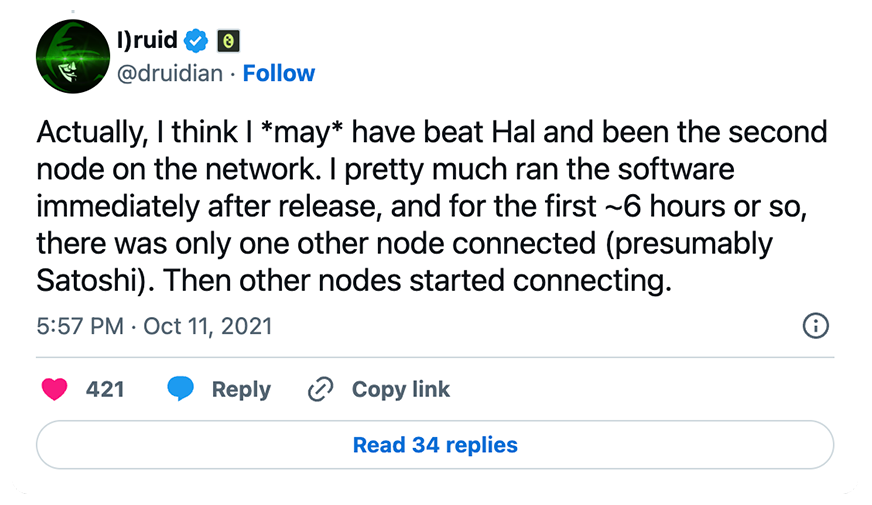
Dustin Trammell is well known in the Bitcoin community and is still active today. More importantly, he’s been very transparent about his early involvement in Bitcoin.
Because of his early involvement, many people have speculated that he might be Satoshi Nakamoto. In response to these lazy speculations, Dustin publicly shared the private emails he exchanged with Satoshi. Given that these conversations occurred very close in time to the events we’ve analyzed, they’re highly relevant to our investigation.
We’ll again proceed under the assumption that these emails are authentic and unmodified.
FWIW, even though I don’t know Dustin personally, based on how he has participated in the community, I have zero reason to believe these emails have been tampered with.
You can find the emails on his personal blog: blog.dustintrammell.com/i-am-not-satoshi/
Direct link to the ZIP archive: https://koi-reindeer-77pb.squarespace.com/s/Satoshi_Nakamoto.zip
You can open them in any text editor, they contain the full email bodies.
The first email is Dustin’s response to the Bitcoin v0.1 announcement that Satoshi made. Dustin’s email server logged Satoshi’s message at: Fri, 2009-01-09 at 03:27 +0800 = 2009-01-08 19:27 UTC
This is about 40 seconds off from the timestamp we see on the Cryptography Mailing List. Which is normal, as email propagation often introduces slight delays.
Below is Dustin’s response to Satoshi’s announcement: Sun, 11 Jan 2009 23:14:04 -0600 ⭢ 12 January 2009 05:14:04 UTC . This was approximately two hours after Block 170 was mined — the block where Satoshi sent Hal 10 bitcoins.
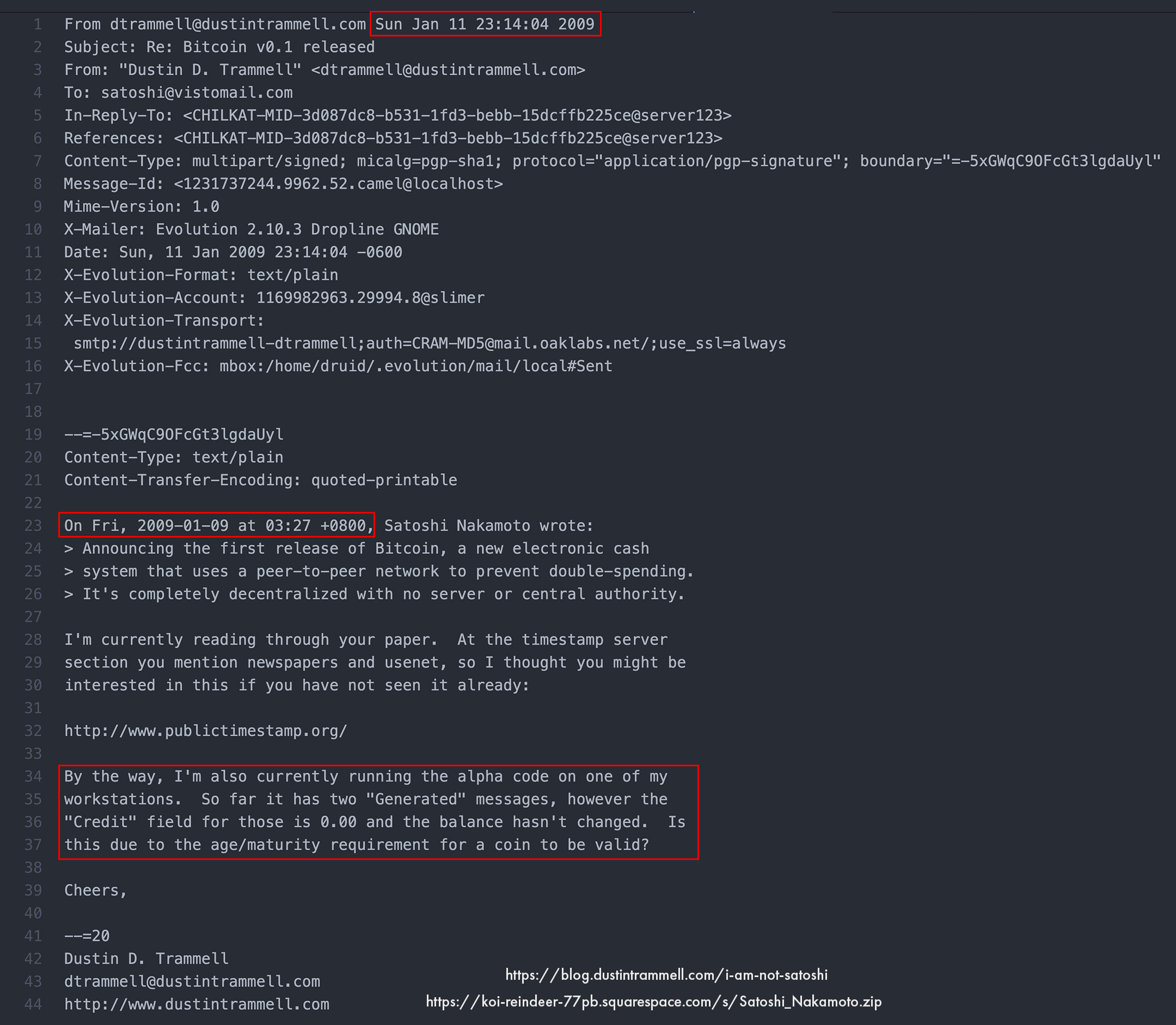
In the email, Dustin mentions that he was running the Bitcoin client and received two “Generated” messages (meaning he mined two blocks) but his balance still showed zero (i.e., the blocks were not yet confirmed).
As noted earlier, Dustin has always been very transparent about his early involvement in Bitcoin and has shared information with the community. In 2021, he published two separate proofs, each containing:
- A Bitcoin address
- A message that was signed
- A cryptographic signature of that message
This is the same type of cryptography used on the blockchain to prove ownership of a private key linked to a Bitcoin address, only here, instead of signing a transaction, Dustin signed a text message.
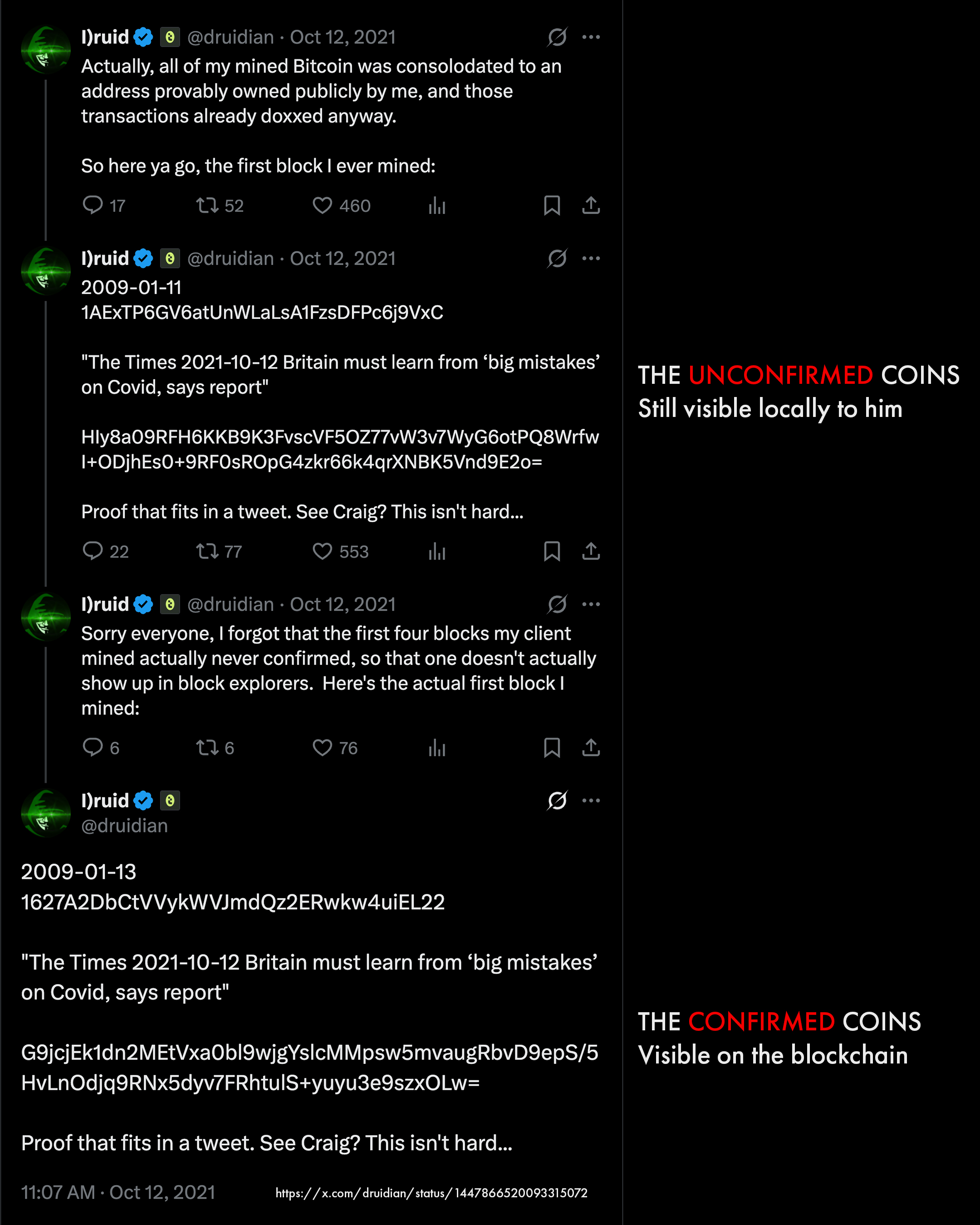
Again, we see Dustin referencing the same unconfirmed transactions (which, of course, do not appear on the blockchain), along with another address dated 13 January. (For reference, Block #1 was mined on 9 January.)
This address did successfully mine bitcoins, and the signature matches, fully consistent with what Dustin described in the email.
As for the unconfirmed coins, we’ll explore what happened to them later.
Verifying Dustin Trammell’s Cryptographic Proof
One thing we can be 100% certain of is that Dustin controls the private key for the address that mined the 50 BTC coinbase reward on 13 January 2009, as he has provided valid cryptographic proof.
Let’s take a look at that proof:
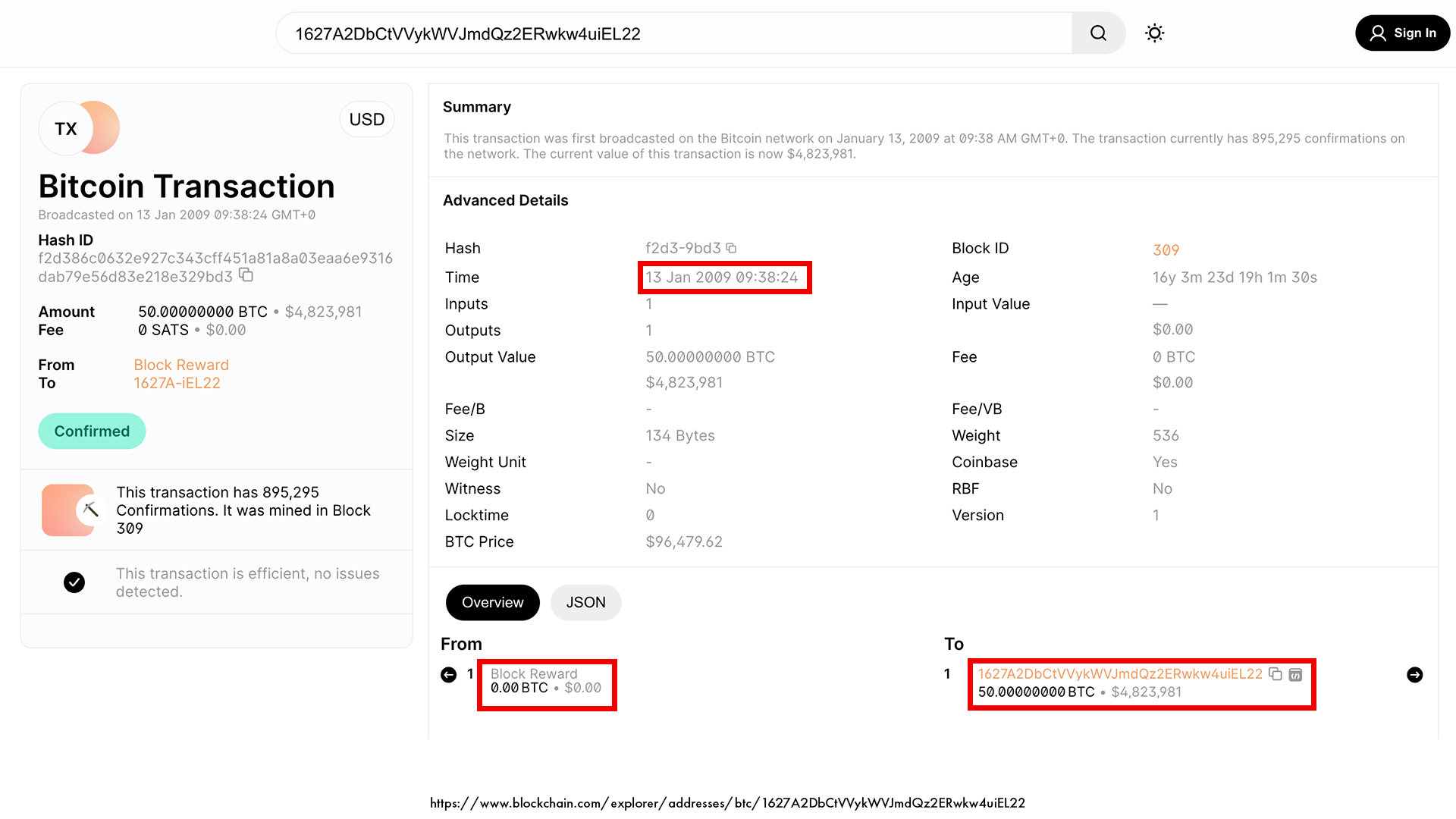
We can see that the address 1627A2DbCtVVykWVJmdQz2ERwkw4uiEL22 (the second example in Dustin’s tweets) did indeed mine 50 bitcoins on 13 January 2009, as indicated by the fact that this was a block reward.
This transaction was sent to a bare public key, so if you view it on mempool.space, it will look different. However, to verify it in Bitcoin Core, we need to convert the public key to a Bitcoin address, which is what blockchain.com displays.
And when we paste the signature, message, and address Dustin shared in his 2021 tweet into Bitcoin Core, we can confirm that he was telling the truth.
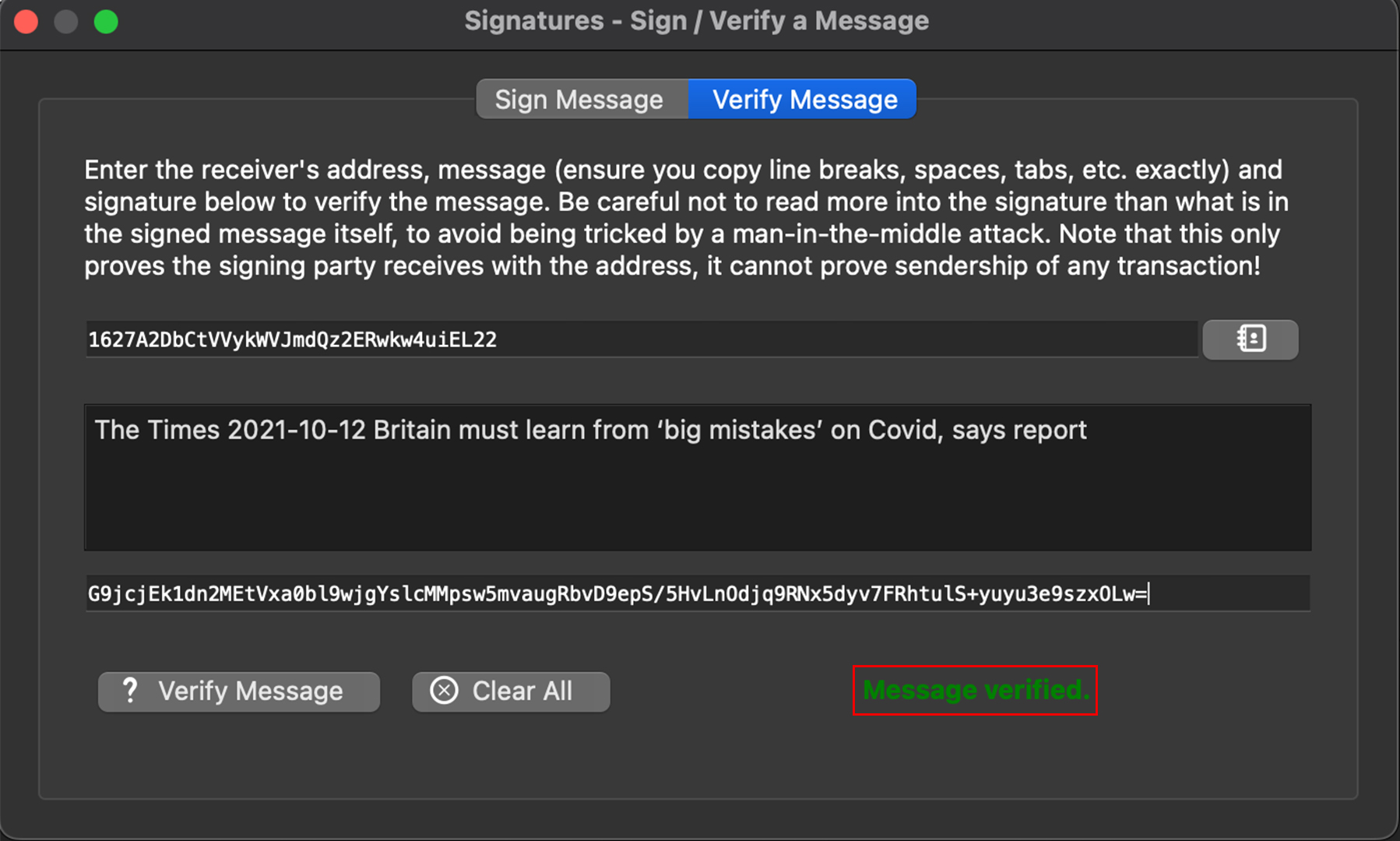
This is great to see, and the block in question, Block 309, is indeed very early. However, it’s still not earlier than:
- Block 49 (seen in Hal’s debug log)
- Block 78 (mined by Hal)
- Or even Block 170 (when Satoshi sent Hal the 10 BTC)
Let’s dig further into the Dustin–Satoshi emails.
On 12 Jan 2009 21:29:52 -0600 ⭢ January 13, 2009 at 03:29:52 UTC , Dustin confirms he was running Bitcoin v0.1.1, when Satoshi advised him to update to v0.1.3, the version that finally worked for Hal.
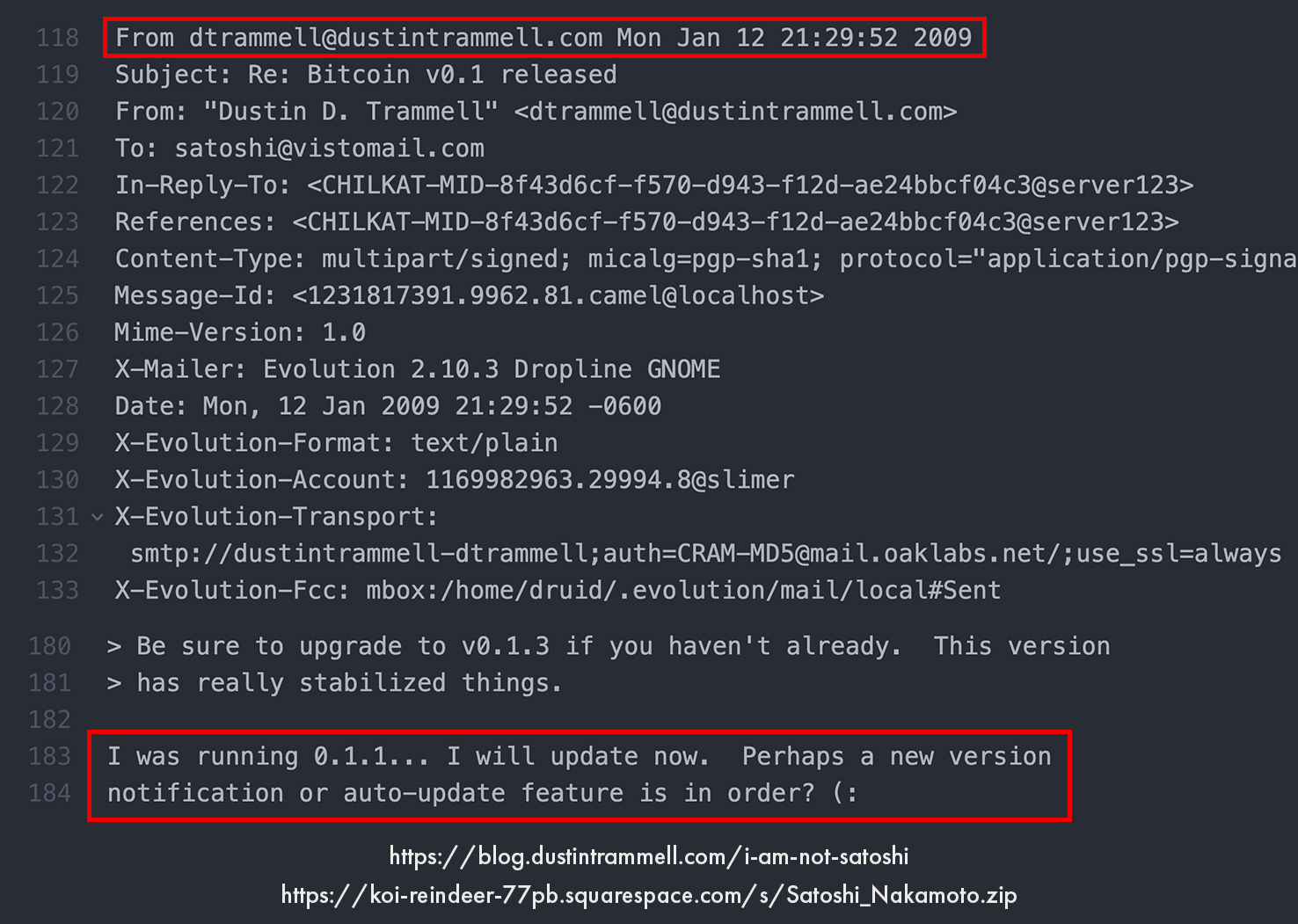
On 13 Jan 2009 07:55:20 -0000 UTC , Satoshi addresses Dustin’s issue with the unconfirmed coins. He confirms that it was a bug in pre-v0.1.3 versions, where the client would become blocked after some time, and although it appeared to remain connected to the network, it was no longer able to communicate with other nodes.
So, if Dustin did mine two blocks, the client was likely unable to broadcast them, which is why they were never confirmed.
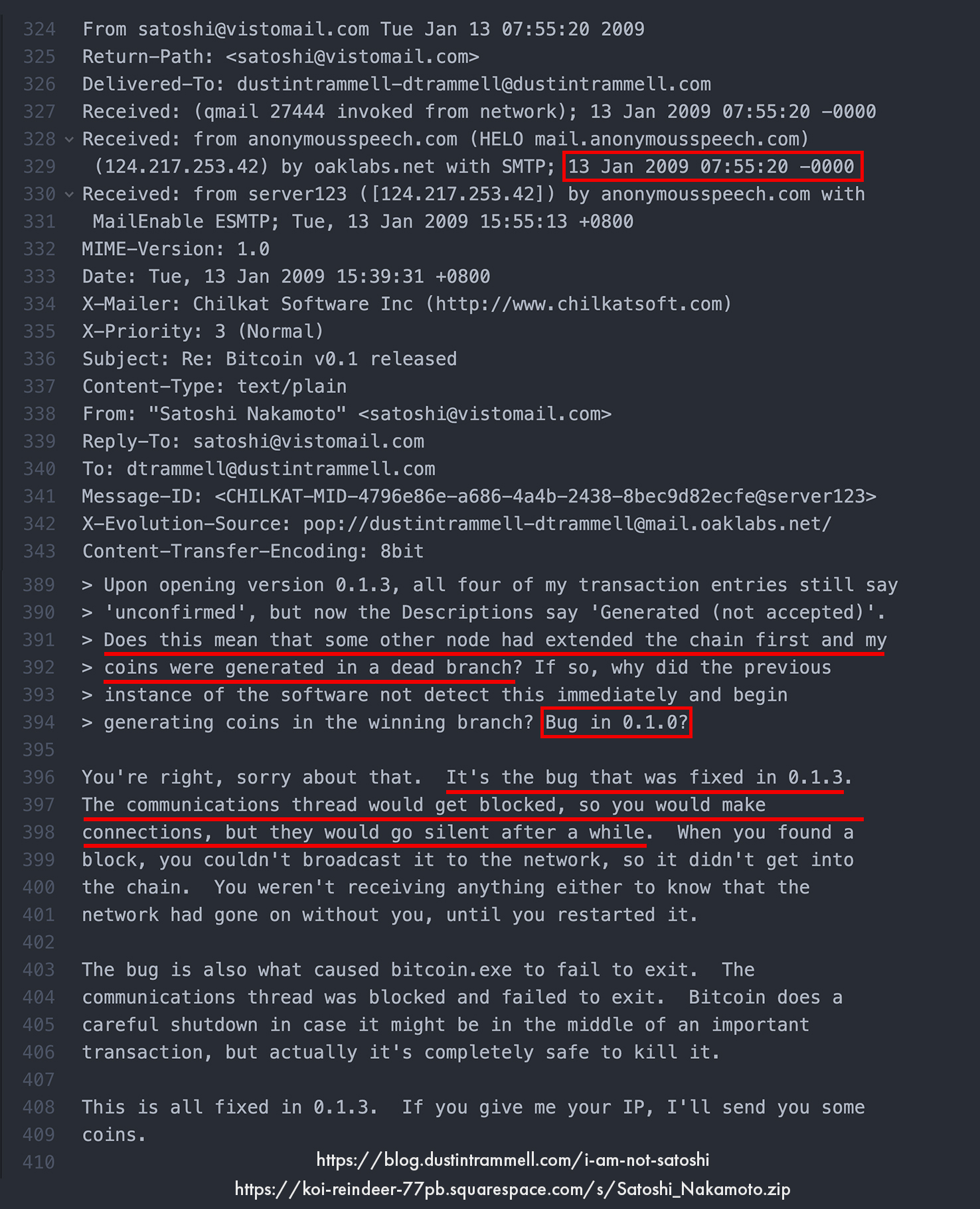
This is actually very interesting, not only is it consistent with what we saw in Hal’s debug file, but it also aligns with Satoshi describing the same issue he helped resolve with Hal.
This email suggests that Dustin was indeed running Bitcoin v0.1.0, and at the same time, it implies that anyone else who tried to run the client back then would have likely encountered the same problem.
This leads me to think that the Tor node may have been Satoshi as well, since anyone else, like Hal or Dustin, running the early client would have hit the same communication issue and been unable to broadcast blocks to the network.
Maybe Satoshi realized this and thought: “Hey, let me spin up another node so the network doesn’t appear stale as more people join.”
Abnormally Long Delays Between Bitcoin Blocks
If we look at the Bitcoin block times before Block 49, we can see that on two separate occasions, the time between blocks was unreasonably long, and one delay of 30 minutes, while not uncommon, also stands out in this context:
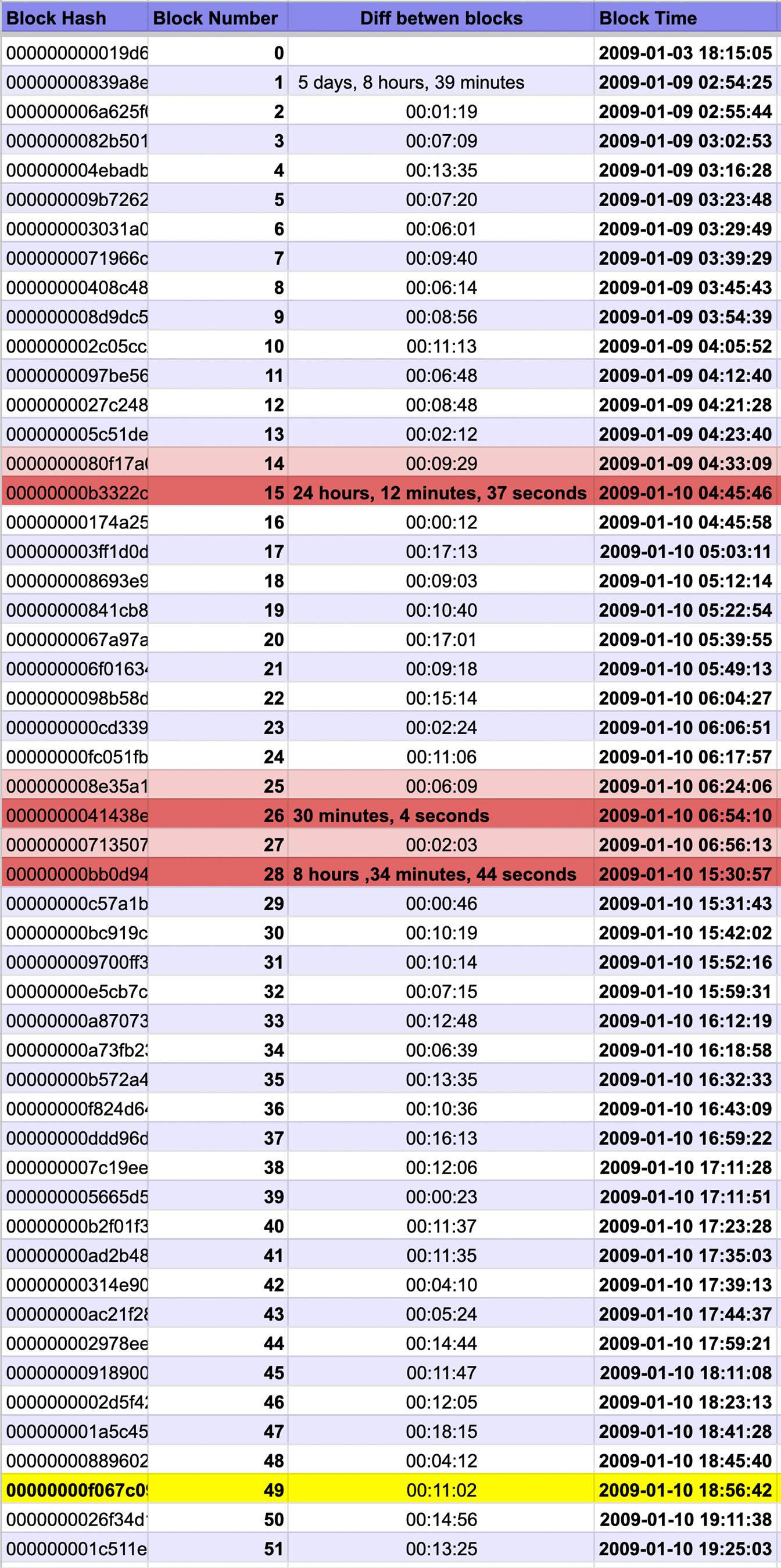
- From Block 14 to 15 ~ 24 hours
- From Block 25 to 26 ~ 30 minutes
- From Block 27 to 28 ~ 8 hours, 34 minutes
Since the starting difficulty was very low at the time, there’s NO way those two long intervals — 8 hours and 24 hours — were statistically probable. Even a low-end computer from 2009 could have mined a Bitcoin block at difficulty 1 in less than 8 hours.
This strongly suggests that the network had halted between those blocks, for exactly that amount of time.
In fact, there are four other such examples of major time delays between blocks, six in total up until block 170.
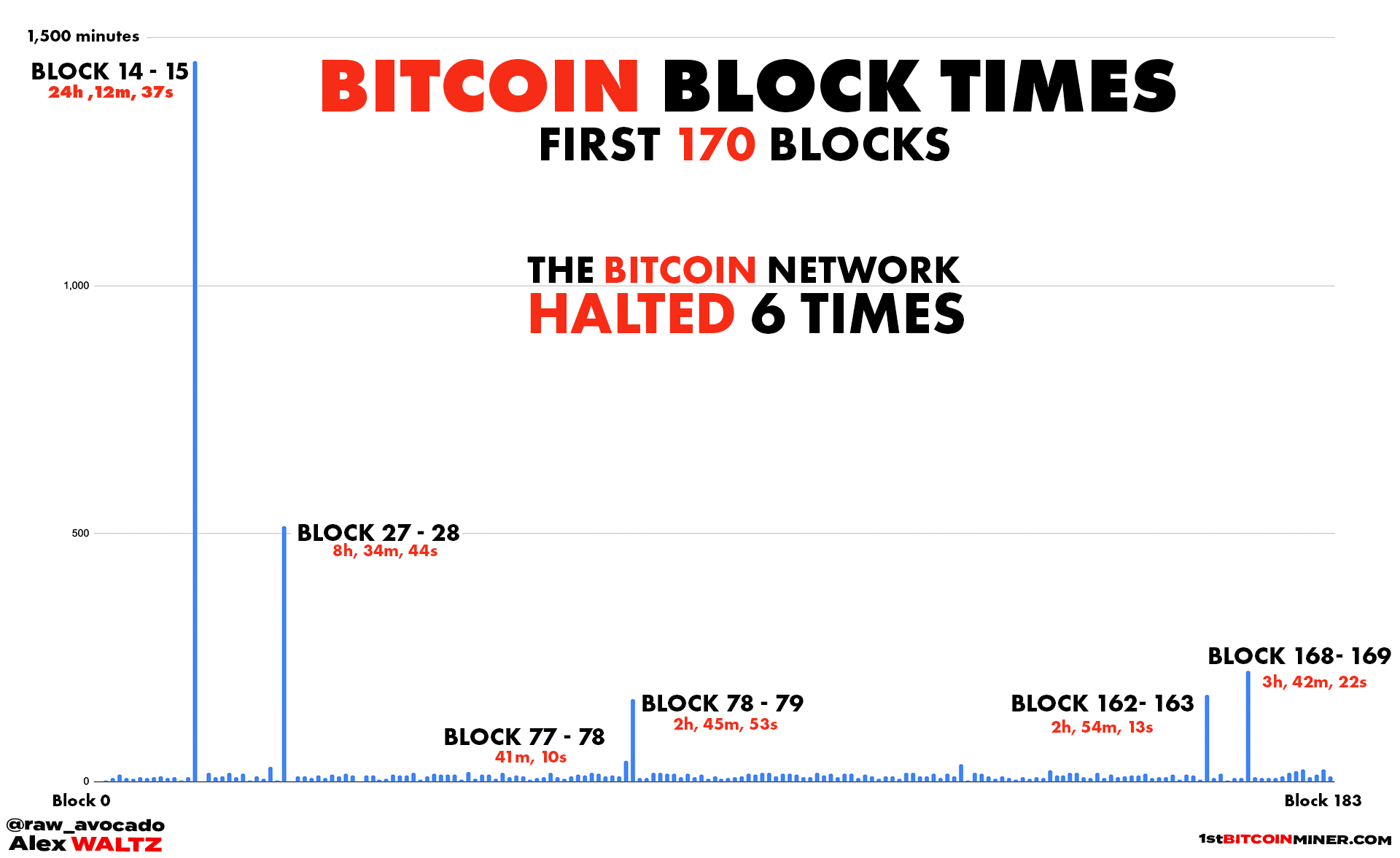
Note: Timestamps are set by miners and can be off by up to two hours. This flexibility was introduced by Satoshi to accommodate potential time misconfigurations on users’ machines. It is a consensus rule and remains part of Bitcoin today. However, given the unusually long time intervals, even with this margin of error, there is still strong evidence of multiple halts.
If we examine the code, we can see that a starting difficulty of 1 required, on average, 2³² hashing operations to find a valid block.
A decent computer from 2009 could handle this without any issue.
So we can confidently rule out the possibility that many people were mining, but simply didn’t have strong enough hardware. The delay was almost certainly due to network inactivity, not hardware limitations.
So, I would lean toward the Tor node also being Satoshi.
It would certainly be helpful to find another source of information to contrast with our findings, but unfortunately, no one else who participated that early in Bitcoin has shared any public information.
The only thing we have from that time is the blockchain itself.
What is the ExtraNonce in Bitcoin?
I’m sure most readers are at least somewhat familiar with how Bitcoin mining works, but let me give you a quick refresher.
A miner takes a set of transactions, places them into a block, hashes all the data, and then broadcasts the block and its hash to other nodes. If the hash of the block is below a certain target value (set by the network), the miner receives the block reward plus any transaction fees.
This target value is tied to the network difficulty; as difficulty increases, the target becomes smaller, making it harder to find a valid hash.
Lowering the target means there are fewer valid outputs, shrinking the search space and increasing the work required to find a solution.
Since SHA-256 outputs are evenly distributed, each hash has the EXACT same probability of being below the target. But that probability is quite small, so miners must calculate a large number of hashes. Essentially, Bitcoin mining is just trying many hashes until one of them hits.
Another important property of SHA-256 is that if you change even a single bit of the input, the output changes drastically, and Satoshi of course knew this.
Since you can’t modify the transaction data, Satoshi added a special field in the block header called the Nonce (short for Number used ONCE).
Mining is simply iterating through values of this Nonce field, from 0 up to its maximum value of 2³² = 4,294,967,296.
Quite often, miners go through the entire Nonce range without finding a valid hash, especially as difficulty increases.
So what happens then?
They use the ExtraNonce. What is an ExtraNonce, you ask? It’s another field in the block that the miner can iterate over.
By incrementing the ExtraNonce, a miner gets a fresh new set of 2³² possible Nonce values to try.
While the Nonce field is explicitly defined in the Bitcoin protocol and must exist in the block header, the ExtraNonce is more of a workaround: miners modify part of the coinbase transaction to generate variation, and that change is referred to as the ExtraNonce.
Now here’s where things get really interesting.
When Satoshi implemented Bitcoin mining, he made a small but important mistake in how the Bitcoin client handled the ExtraNonce.
You would think that once a miner finds a valid block, they would reset the ExtraNonce and start fresh with a new block. But in the first versions of Bitcoin, that’s not how it worked.
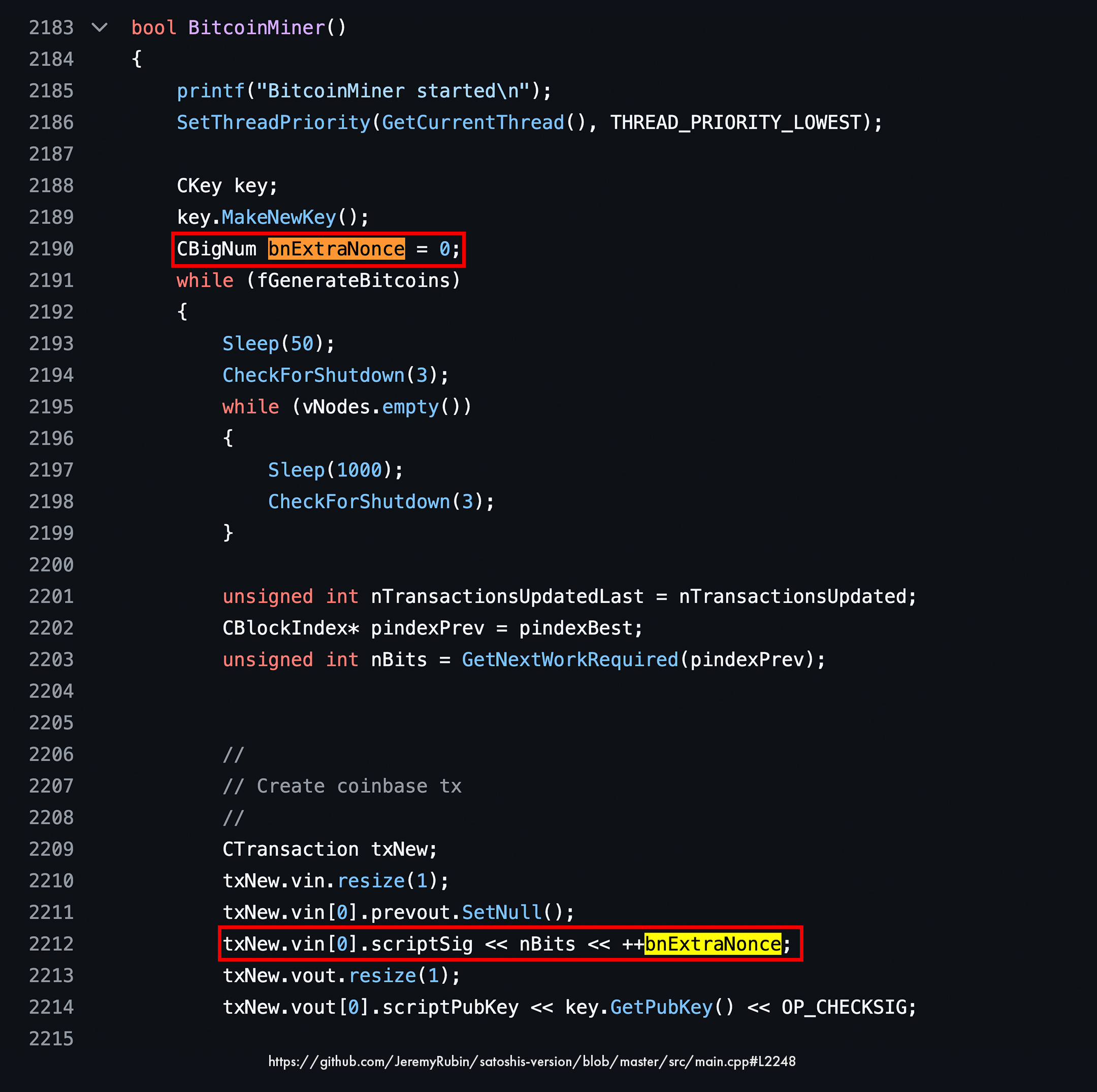
Because of how Satoshi implemented the use of the ExtraNonce, it led to three unintended consequences:
The ExtraNonce only resets if you restart or shut down the Bitcoin client — not after a block is found
The ExtraNonce increments not just when the Nonce overflows, but also when the miner attempts to construct a new block candidate.
The ExtraNonce also increments when a valid block is received from another node, again unrelated to Nonce overflow. This is because when checking the validity of the received block, the node has to call the
fGenerateBitcoinsfunction, thus triggering the ExtraNonce increment.
This behavior is due to:
bnExtraNonceonly being initialized to 0 before thewhile (fGenerateBitcoins)loop.The position of
++bnExtraNoncerelative to coinbase creation.The overall structure of the
fGenerateBitcoinsloop in the early client.
So, under normal operation (only in this very early version of the client, this changed later), a node would increment the ExtraNonce not just when the Nonce range was exhausted, but whenever one of the above events occurred.
Because the ExtraNonce is embedded in the coinbase transaction of each block, it leaves a visible trace on the blockchain — essentially a counter showing how often it was incremented.
This is extremely useful for our investigation because:
The ExtraNonce acts like a rough uptime counter that can indicate how long a Bitcoin client has been running.
If we see a series of blocks with consecutive or gradually increasing ExtraNonce values, we can reasonably infer that they came from the same miner.
If we see a block with ExtraNonce = 0, it likely came from a freshly started client.
By the way, this behavior was discovered by Sergio Demian Lerner in 2013, who had the genius idea to look at the ExtraNonce data, which he used to develop the famous Patoshi Pattern Theory. His research led him to estimate that the so-called Patoshi miner (likely Satoshi) mined somewhere between 700,000 and 1 million bitcoins.
Regardless of whether you agree with his conclusion, two things are undeniable:
What is written in the code (how the ExtraNonce was incremented).
What is written on the blockchain (the ExtraNonce published in each coinbase transaction).
ExtraNonce + Long Block Delays
The good news is that even if you disagree with Sergio’s conclusions, perhaps due to concerns that the data is too noisy, this doesn’t pose a problem for our investigation, because:
We’re dealing with the very first days of Bitcoin’s existence, and there was very little interest shown on the Cryptography Mailing List at the time. That means we’re looking at a very small number of participants.
We have additional evidence from Hal’s
debug.logfile, which shows that around Block 49, there were only two other nodes present. It’s hard to imagine that hundreds of participants suddenly rushed in all of a sudden — especially given the extremely long time delays between blocks.
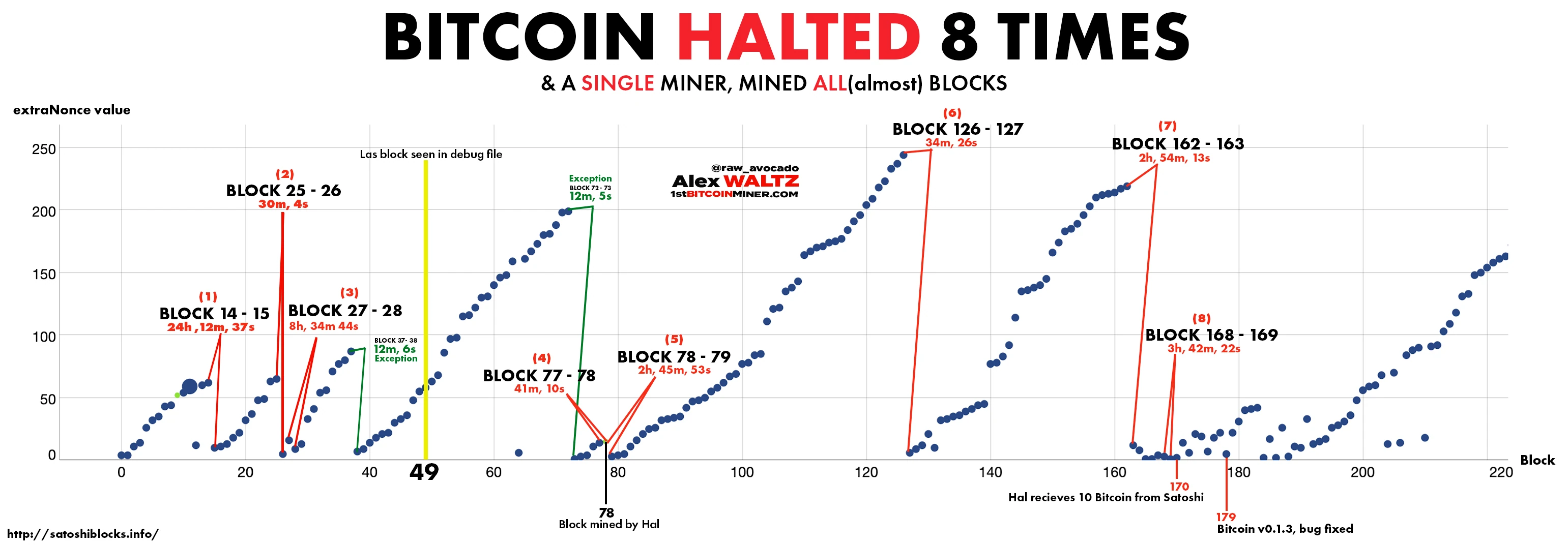
In the chart above, we have blocks on the X-axis and ExtraNonce values on the Y-axis.
The chart goes up to around Block 170, because that’s roughly when the following key events occurred:
- Satoshi sent Hal the 10 Bitcoins
- Hal made the famous “Running Bitcoin” tweet
- Satoshi released Bitcoin v0.1.3 — the first version that ran without issues
We can see clusters of navy blue dots forming visible patterns, where the ExtraNonce of consecutive blocks increases steadily.
This allows us to reasonably infer that each distinct grouping of blue dots corresponds to a single miner. The longer the ExtraNonce pattern, the stronger the assumption.
While ExtraNonce incrementation is not entirely random, it’s still chaotic and unpredictable, so when we observe consecutive values, we can assign a high degree of confidence that those blocks came from the same mining entity.
Another thing we can observe is that each time the ExtraNonce resets, there’s a large time gap between blocks. Since we know the ExtraNonce counter resets when a node restarts (or shuts down), this is a very strong indicator that most of the blocks were mined by one entity, and when this entity was offline, no one else was mining blocks.
Remember, the difficulty at this time was very low. During this period, if a decent computer had been online, it would have been fairly easy to find a block in 10 minutes, let alone in a few hours.
In addition to this, we know from Hal’s debug.log file that around Block 49, there were only two other nodes present: one using a clearnet IP (most likely Satoshi), and the other behind Tor.
Block 49 is part of the run from Block 38 to Block 72, and one of the two exceptions where the extraNonce resets and we have a normal (something close to 10 minutes) time gap. The extraNonce reset happens from Block 72 to Block 73.
In fact, if we examine the time intervals between blocks from Block 29 to Block 77, the average interval is 10.7 minutes — what we would expect if someone were consistently present and mining.

In other words, the only time the network operates without any halts is during the period when we know for certain that both Satoshi and the Tor node were present.
All of these factors lead me to believe that the Tor node was also Satoshi.
What I suspect was happening here is that Satoshi was operating both nodes (the Tor node and the clearnet one) and that during this run, he was actively present at his machines, likely incorporating feedback from Hal while working on the code. However, whenever those longer gaps occurred, it appears he went offline for some reason.
This email from Mon, Jan 12, 2009 at 8:41 AM (PST) ⭢ Monday, 12 January 2009 16:41:00 UTC (one day after Hal received Bitcoin v0.1.3, the first stable version) confirms both that Satoshi may have been traveling, or otherwise lacked access to his main machine, and that he was using Tor during this time (from Wall Street Journal emails).
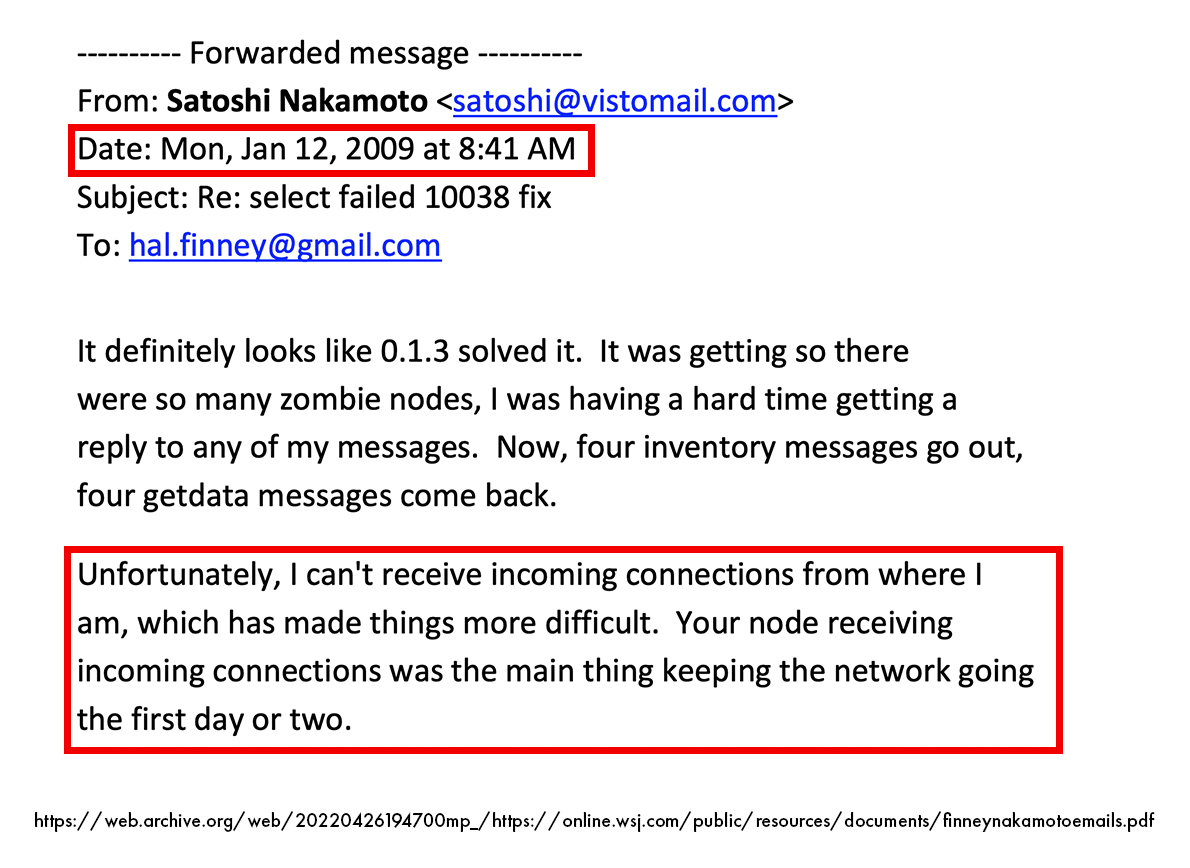
Remember, Tor nodes cannot accept incoming connections.
It’s also interesting to note that Satoshi credited Hal with essentially keeping the network alive, despite the issues it was experiencing at the time.
To be extra clear: Everything I’m presenting here is educated speculation and reasoned interpretation based on the available evidence — but it’s not 100% proof.
When I say there’s a high probability of certain events or conclusions, that does not mean they are guaranteed. Freak events can and do happen — they’re just statistically less likely.
I absolutely stand by everything I’ve said here; I just want to make it clear which parts of this investigation are speculative.
What If Dustin Trammell Was the Tor Node?
This speculation can be ruled out quite easily.
On Jan 13 18:40:28 2009
, Dustin shared his IP address with Satoshi so that Satoshi could send him some coins , specifically to 24.28.79.95.
It’s highly unlikely that Dustin was using Tor at the time, and then suddenly switched to a clearnet IP.
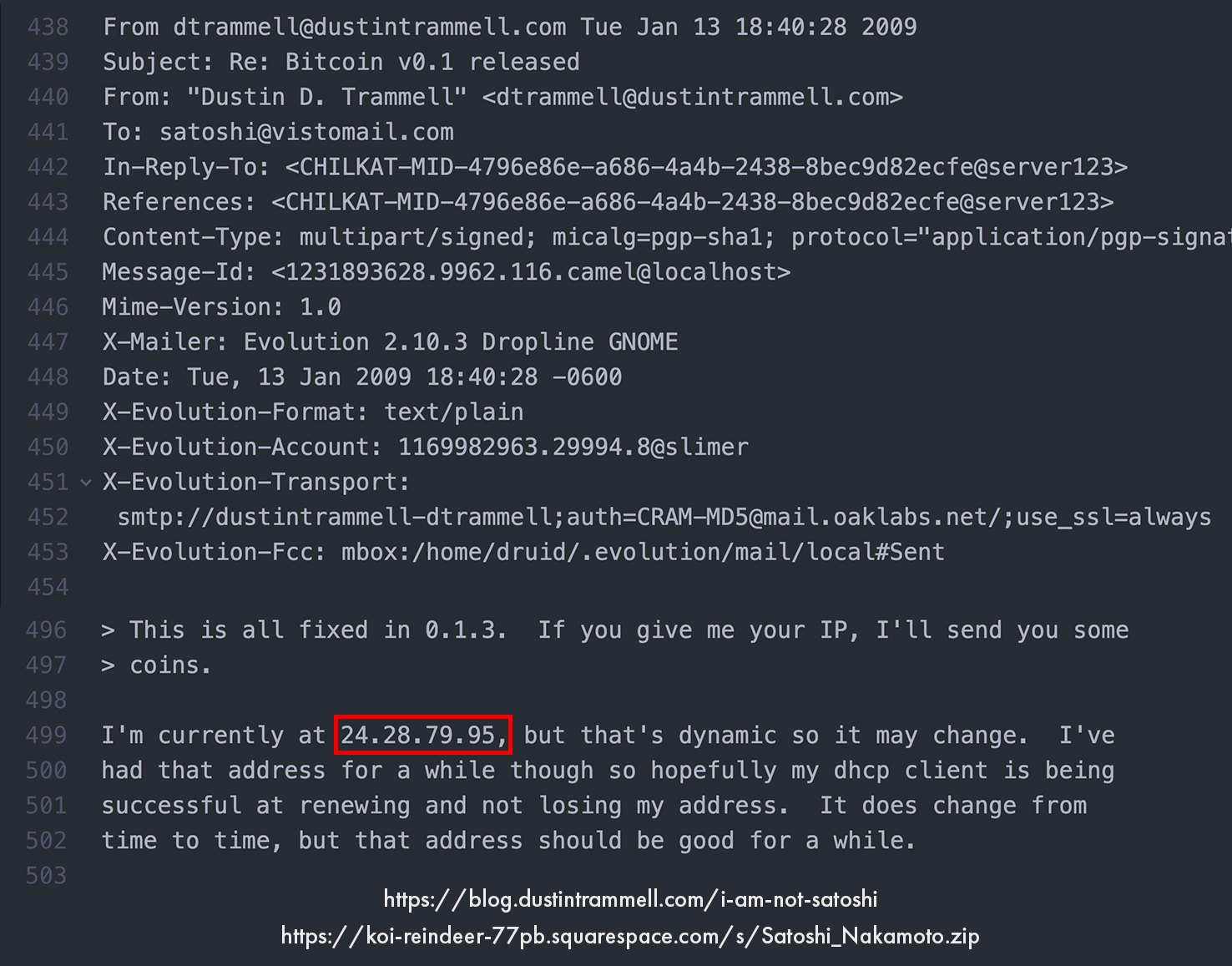
As mentioned earlier, the early versions of Bitcoin allowed users to send Bitcoins directly to an IP address. A user would share their IP, your node would connect to theirs using that address, request a public key, and then send the coins to that key.
Even though Bitcoin addresses were supported, many early transactions used bare public keys. That’s why Dustin shared his IP address with Satoshi in that email.
At this point, we can move on to the last pieces of evidence, two tweets made by Dustin Trammell:
- In 2023
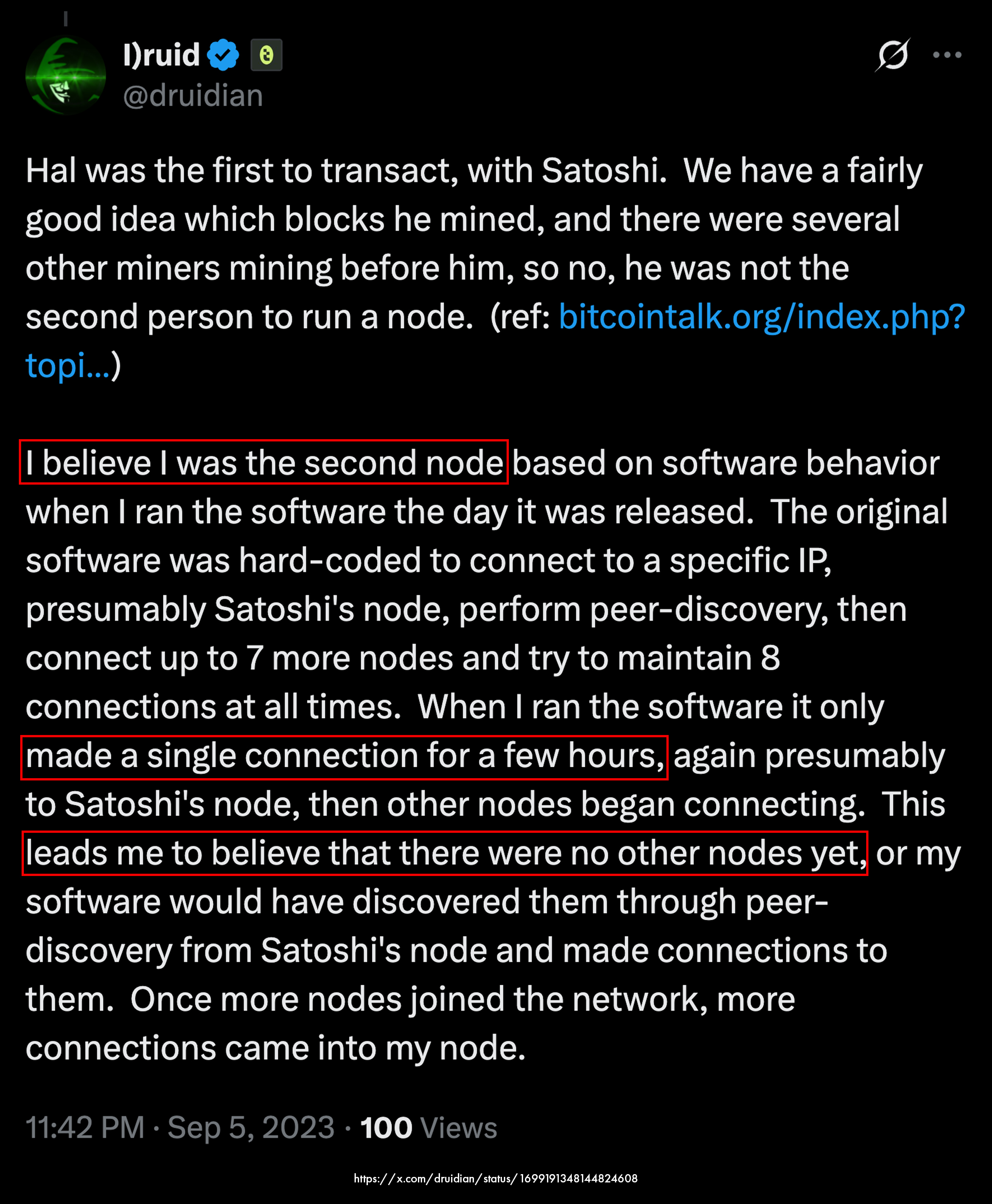
- In 2021
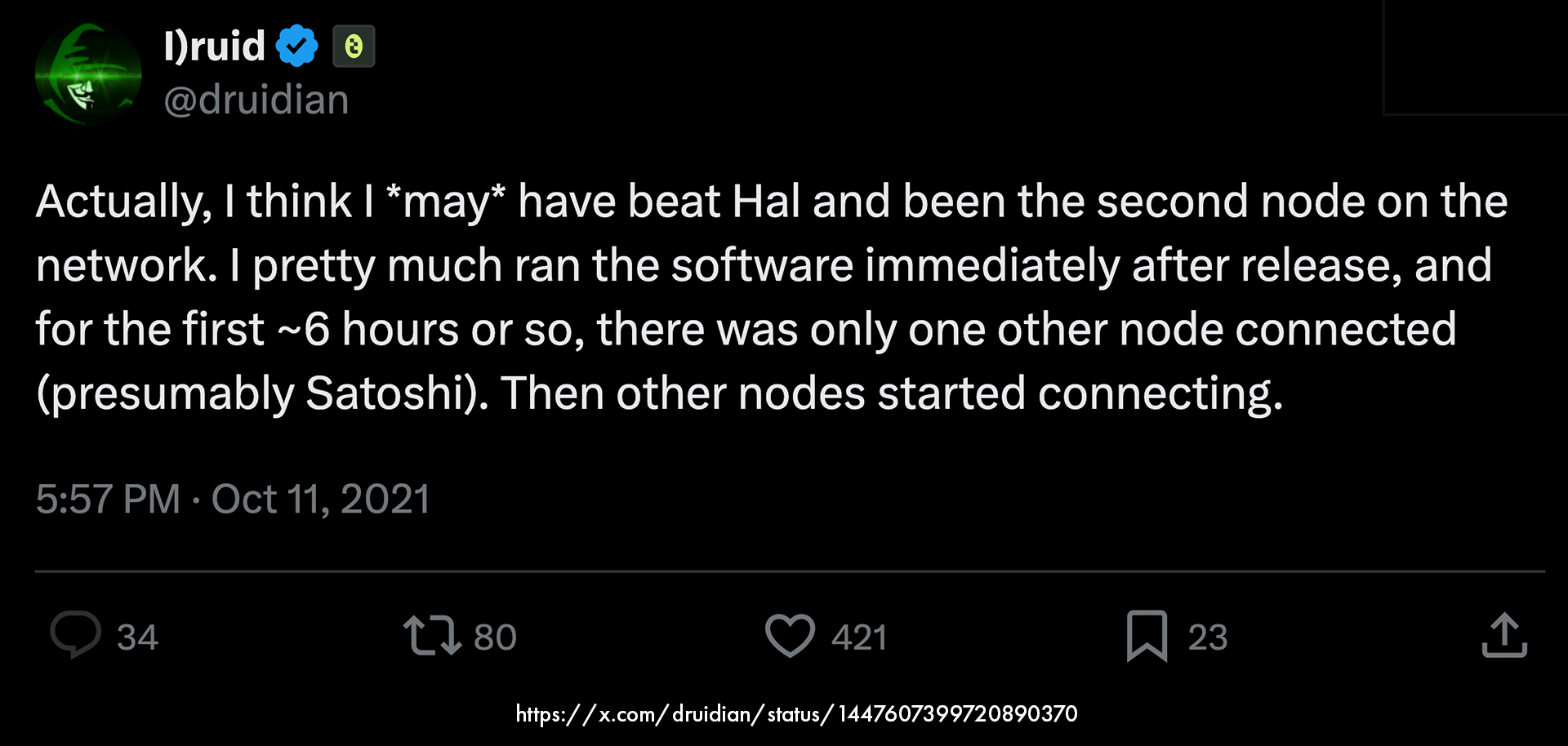
It’s interesting to see that Dustin reached the same conclusion as we did: That Hal was NOT the second node to join the network (with Satoshi being the first), and that there were other miners before Hal — which aligns perfectly with our findings.
Dustin suspects that he was the second node to join the Bitcoin network, before Hal.
He clearly states that his node only made one connection. But was this because there were no other nodes online? Or due to connection issues?
What Dustin describes in the tweet makes a lot of sense.
Even though Hal first tried Bitcoin around Block 49, he only managed to get it working much later. So when Dustin ran his client, it’s possible that only Satoshi’s node was online and visible.
But what about the Tor node?
Well, a Tor node cannot accept incoming connections, so the only node Dustin could have connected to would have been Satoshi’s.
However, this still leaves one open question:
Why didn’t either Satoshi’s clearnet node or the Tor node connect to Dustin’s node?
With the evidence we currently have, we can say with 100% certainty that Dustin controls the private key to the address that mined Block 309.
But can we find evidence that places him before this block?
We may never know with absolute certainty if he did mine the two unconfirmed blocks he referenced, but since everything else he’s shared aligns well with our independent analysis, we’ll give Dustin the benefit of the doubt.
Dustin doesn’t mention a specific timestamp for those unconfirmed blocks, only the date: January 11th.
So, for reference, let’s add both the first and last blocks of that day into our table: Block 76 and Block 168.
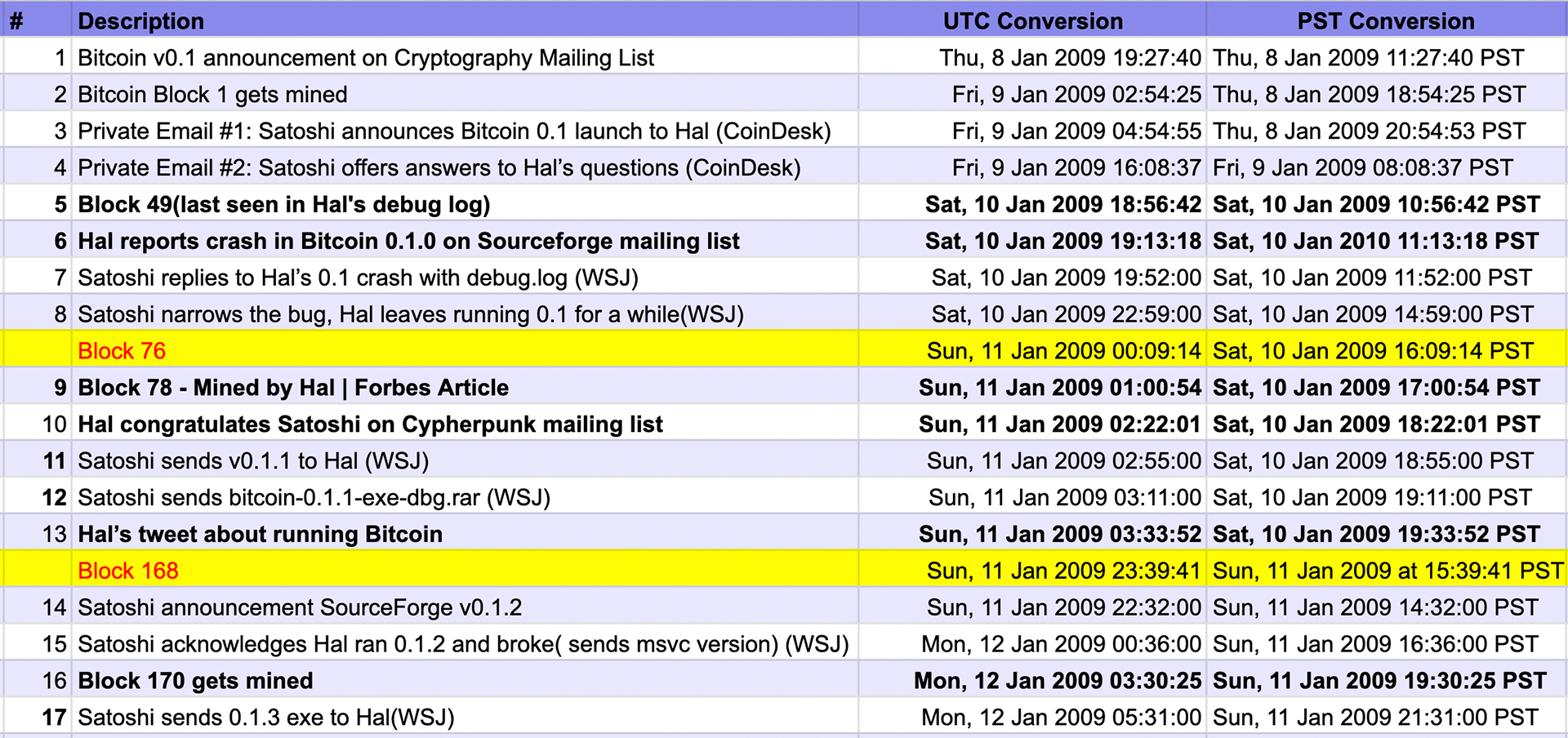
Clickable Table
| # | Description | UTC Conversion | PST Conversion |
|---|---|---|---|
| 1 | Bitcoin v0.1 announcement on Cryptography Mailing List | Thu, 8 Jan 2009 19:27:40 | Thu, 8 Jan 2009 11:27:40 PST |
| 2 | Bitcoin Block 1 gets mined | Fri, 9 Jan 2009 02:54:25 | Thu, 8 Jan 2009 18:54:25 PST |
| 3 | Private Email #1: Satoshi announces Bitcoin 0.1 launch to Hal (CoinDesk) | Fri, 9 Jan 2009 04:54:55 | Thu, 8 Jan 2009 20:54:53 PST |
| 4 | Private Email #2: Satoshi offers answers to Hal’s questions (CoinDesk) | Fri, 9 Jan 2009 16:08:37 | Fri, 9 Jan 2009 08:08:37 PST |
| 5 | Block 49(last seen in Hal's debug log) | Sat, 10 Jan 2009 18:56:42 | Sat, 10 Jan 2009 10:56:42 PST |
| 6 | Hal reports crash in Bitcoin 0.1.0 on Sourceforge mailing list | Sat, 10 Jan 2009 19:13:18 | Sat, 10 Jan 2010 11:13:18 PST |
| 7 | Satoshi replies to Hal’s 0.1 crash with debug.log (WSJ) | Sat, 10 Jan 2009 19:52:00 | Sat, 10 Jan 2009 11:52:00 PST |
| 8 | Satoshi narrows the bug, Hal leaves running 0.1 for a while(WSJ) | Sat, 10 Jan 2009 22:59:00 | Sat, 10 Jan 2009 14:59:00 PST |
| Block 76 | Sun, 11 Jan 2009 00:09:14 | Sat, 10 Jan 2009 16:09:14 PST | |
| 9 | Block 78 - Mined by Hal | Forbes Article | Sun, 11 Jan 2009 01:00:54 | Sat, 10 Jan 2009 17:00:54 PST |
| 10 | Hal congratulates Satoshi on Cypherpunk mailing list | Sun, 11 Jan 2009 02:22:01 | Sat, 10 Jan 2009 18:22:01 PST |
| 11 | Satoshi sends v0.1.1 to Hal (WSJ) | Sun, 11 Jan 2009 02:55:00 | Sat, 10 Jan 2009 18:55:00 PST |
| 12 | Satoshi sends bitcoin-0.1.1-exe-dbg.rar (WSJ) | Sun, 11 Jan 2009 03:11:00 | Sat, 10 Jan 2009 19:11:00 PST |
| 13 | Hal’s tweet about running Bitcoin | Sun, 11 Jan 2009 03:33:52 | Sat, 10 Jan 2009 19:33:52 PST |
| Block 168 | Sun, 11 Jan 2009 23:39:41 | Sun, 11 Jan 2009 15:39:41 PST | |
| 14 | Satoshi announcement SourceForge v0.1.2 | Sun, 11 Jan 2009 22:32:00 | Sun, 11 Jan 2009 14:32:00 PST |
| 15 | Satoshi acknowledges Hal ran 0.1.2 and broke( sends msvc version) (WSJ) | Mon, 12 Jan 2009 00:36:00 | Sun, 11 Jan 2009 16:36:00 PST |
| 16 | Block 170 gets mined | Mon, 12 Jan 2009 03:30:25 | Sun, 11 Jan 2009 19:30:25 PST |
| 17 | Satoshi sends 0.1.3 exe to Hal(WSJ) | Mon, 12 Jan 2009 05:31:00 | Sun, 11 Jan 2009 21:31:00 PST |
Even if Dustin joined the network as early as Block 76, that would still place him after Hal, who, as we’ve seen from the private emails, the debug.log file, and the SourceForge mailing list post, was already active just before Block 49.
So based on all the evidence we’ve gathered, it seems that Hal did run Bitcoin before Dustin.
The title asks “Who Was the 1st Bitcoin Miner?”, and given the level of scrutiny we’ve applied so far in our analysis, it only makes sense to keep splitting hairs.
Yes. Provably, Hal still beats Dustin: Hal mined Block 78, while Dustin’s first confirmed block is Block 309.
What I find fascinating though is this:
If Dustin had mined his first block on January 11th, he would have been the first miner after Satoshi, beating Hal by two blocks… but we wouldn’t be able to prove it.
It’s also worth mentioning that in his appearance on the Stephan Livera Podcast (Episode 314), Dustin says that he downloaded the Bitcoin Whitepaper shortly after its release, was eagerly waiting for the software to be published, and ran the Bitcoin client very shortly after it was released.
However he did not realised that the mining function was turned off by default.
Satoshi probably made this decision intentionally: If people ran the software and saw it consuming a lot of CPU, they might have panicked and shut it down.
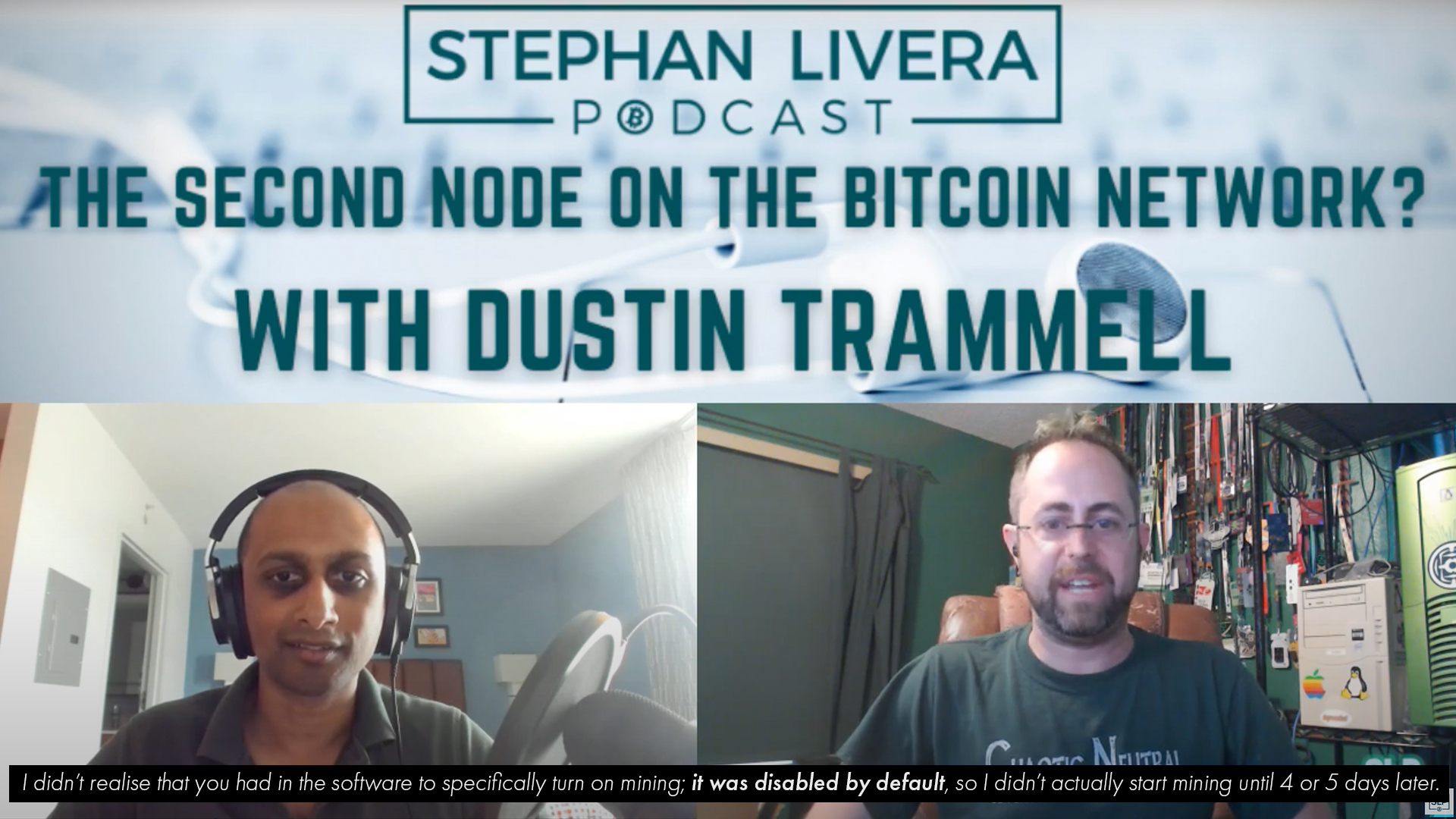
This small default setting explains a lot:
- Why Satoshi was the only miner in the very beginning
- Why others (like Hal and Dustin) ran the client but didn’t mine
- Why, if there were any other early participants, they wouldn’t have left any traces
This matches perfectly with our earlier ExtraNonce analysis — even if others were present, they weren’t mining.
Early Bitcoin Satoshi-Client Peer Discovery
For the sake of accuracy, I want to clarify that the hardcoded IP address Dustin mentioned in his tweet was not Satoshi’s IP, but rather the fallback IP for the Freenode IRC server, as we can see in the code hosted on SourceForge:
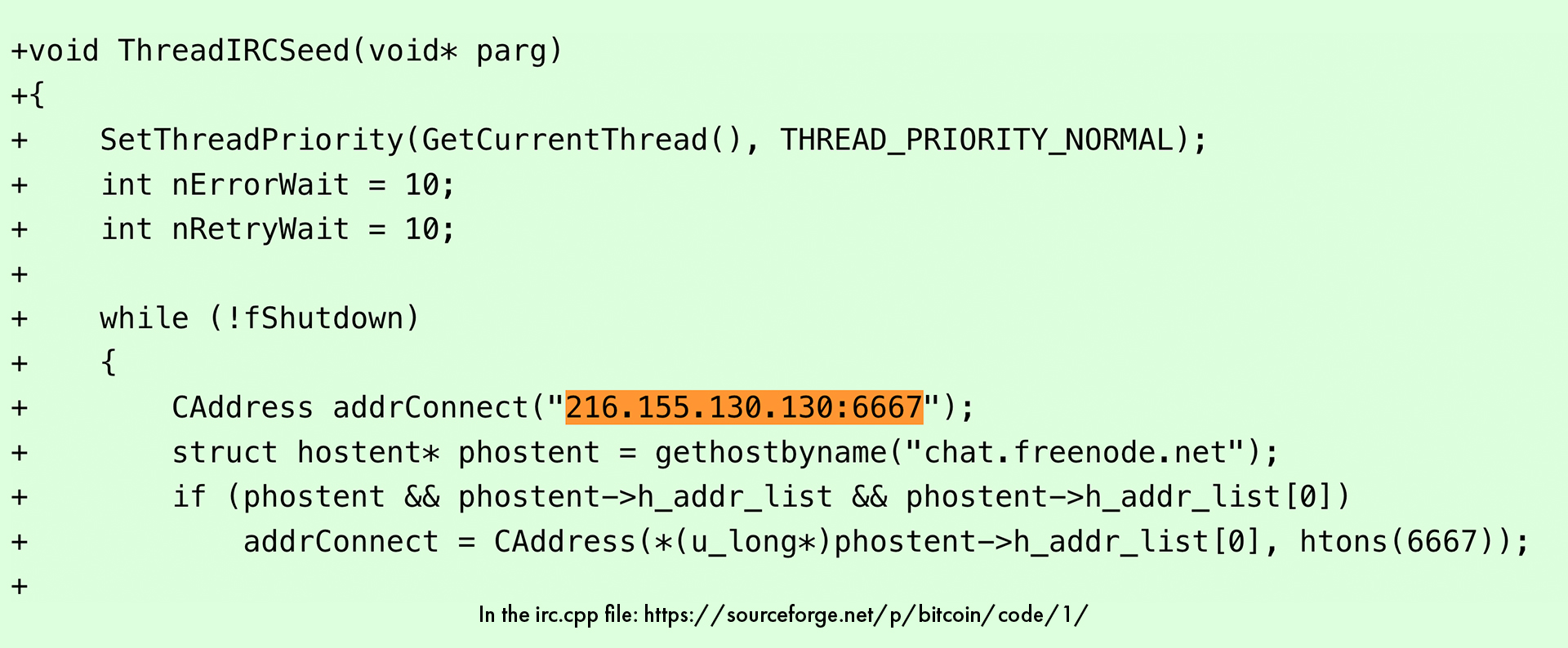
The earliest versions of Bitcoin source code I could find (satoshi.nakamotoinstitute.org/code/) are Bitcoin v0.1.1 and Bitcoin v0.1.3. The hash for v0.1.3 match those in the RSS feed from SourceForge (archived on web.archive.org), and neither v0.1.1 nor v0.1.3 contains the fallback IP
216.155.130.130inirc.cpp.
The screenshot with the green background is from SourceForge. The earliest accessible version available there is v0.1.5, which is also the earliest version I could find that contains the fallback IRC IP.
This detail doesn’t invalidate any of the other points Dustin made, and it’s an easy thing to mix up.
So what Is the Grand Conclusion?
So in this article, we dethroned Hal Finney from being the 2nd node to join the Bitcoin Network to the 3rd node, thus making him the 3rd person also, but then we re-instated him to the 2nd person, as we suspect the Tor node was also Satoshi Nakamoto.
We found out some never-known facts about Bitcoin’s inception, which after all these years is quite something:
- Hal Finney missed Bitcoin’s launch
- Hal Finney joined the Bitcoin network around Block 49
- There were 2 nodes online when he joined; both were Satoshi Nakamoto
- The Bitcoin network halted for 24h and 8h in the first 30 blocks
- In total, Bitcoin halted 8 times in the first 170 blocks
But more importantly, we got a very intimate view of how fragile these early days were, and how Bitcoin barely took off.
But anyway, in the grand scheme of things, it doesn’t matter who actually was 1st and who was 2nd node or miner.
What matters is that there were some people at this very early and fragile starting point of Bitcoin who decided to run the Bitcoin Client, and if not for them, Bitcoin may have never taken off.
Here there were all these cryptographers on the Cryptography Mailing List, most of them looking for the next breakthrough, and one day, out of nowhere, an anonymous guy drops one of the biggest inventions/discoveries of the century, and almost everyone ignores it!
But for some reason, Dustin and Hal looked at this strange project that promised so much, without any trace of cynicism, and judged it for what it is.
They saw Bitcoin as Bitcoin, not as “Bitcoin made by this strange Satoshi character.”
And because of this very simple and honest gesture, they changed the world and deserve a place in history. And for that, I want to say a very sincere thank you, gentlemen. 🫡
Another important thing to note is that Hal’s debug file was available for 16 years, and the emails for 10, and yet no one bothered to look at them. Even when Dustin himself mentioned he was the 1st, only 100 people took interest in the tweet.
So if you take anything from this very long article, I hope it is this: ALWAYS verify what other people are saying. And next time you encounter a strange new idea that makes big promises — be like Hal and Dustin. You may just change the world yourself.
P.S. I hope this also puts to rest all the theories that Bitcoin was started by three-letter agencies, aliens, AI, aliens with AI, a group of people, etc. It looks an awful lot like a guy who wrote some code, put it on the internet, and made all the chaotic mistakes that come with it.
If you found this article valuable, please consider making a donation.
It took about 3.5 months to research and write the article, plus another month to put together the website, clean up the formatting, and create a scrappable data section to make it easier for people to re-use my work.
All of my content is free, and I always go the extra mile to keep things thorough, sourced, and easy to navigate.
- LN:
sappybeggar14@walletofsatoshi.com - On-chain:
bc1q5kaj2fyps8sqhdmf99kzzzvz45qyu7zzhjzh2r - Dirty-fiat:
buymeacoffee.com/alexwaltz
